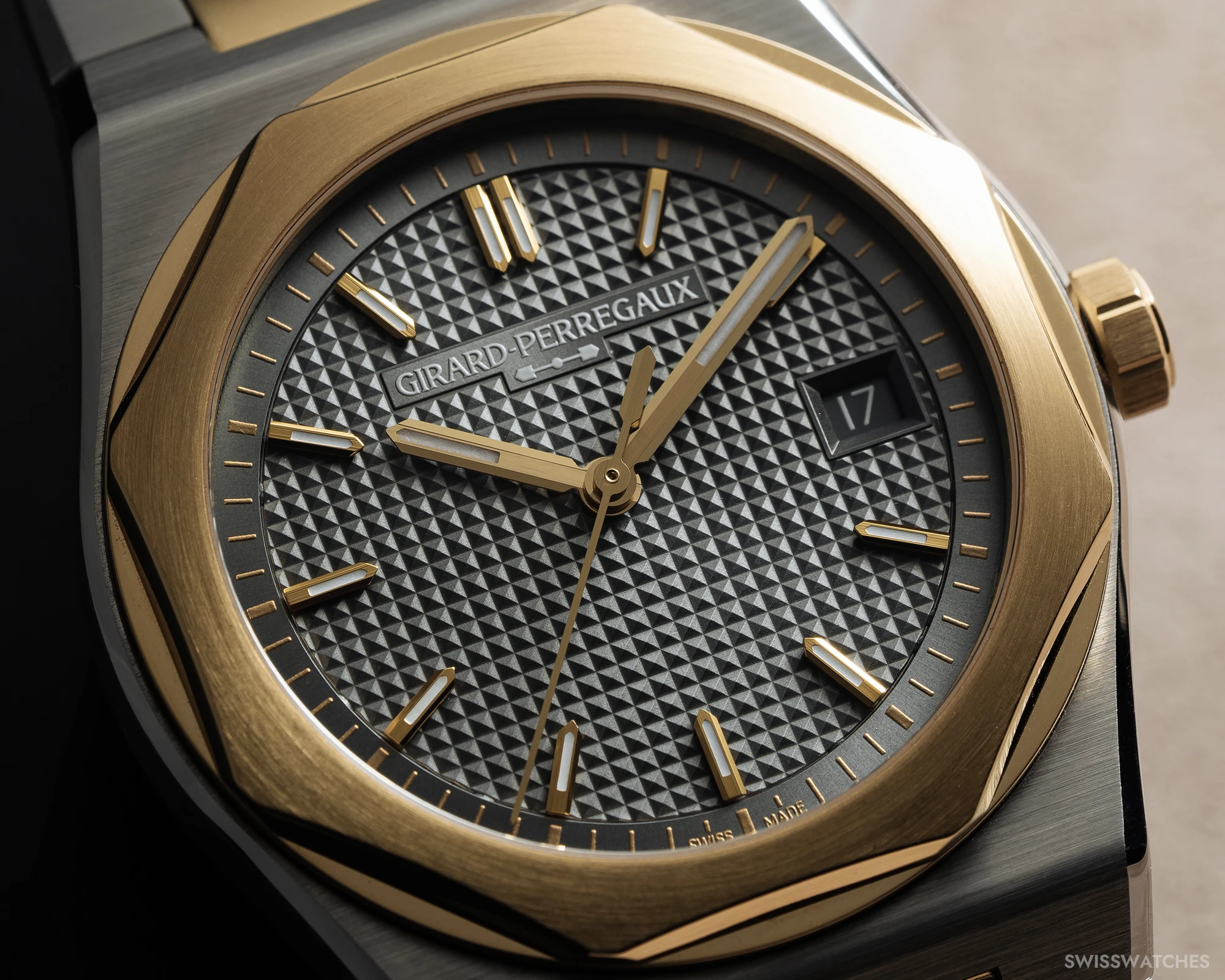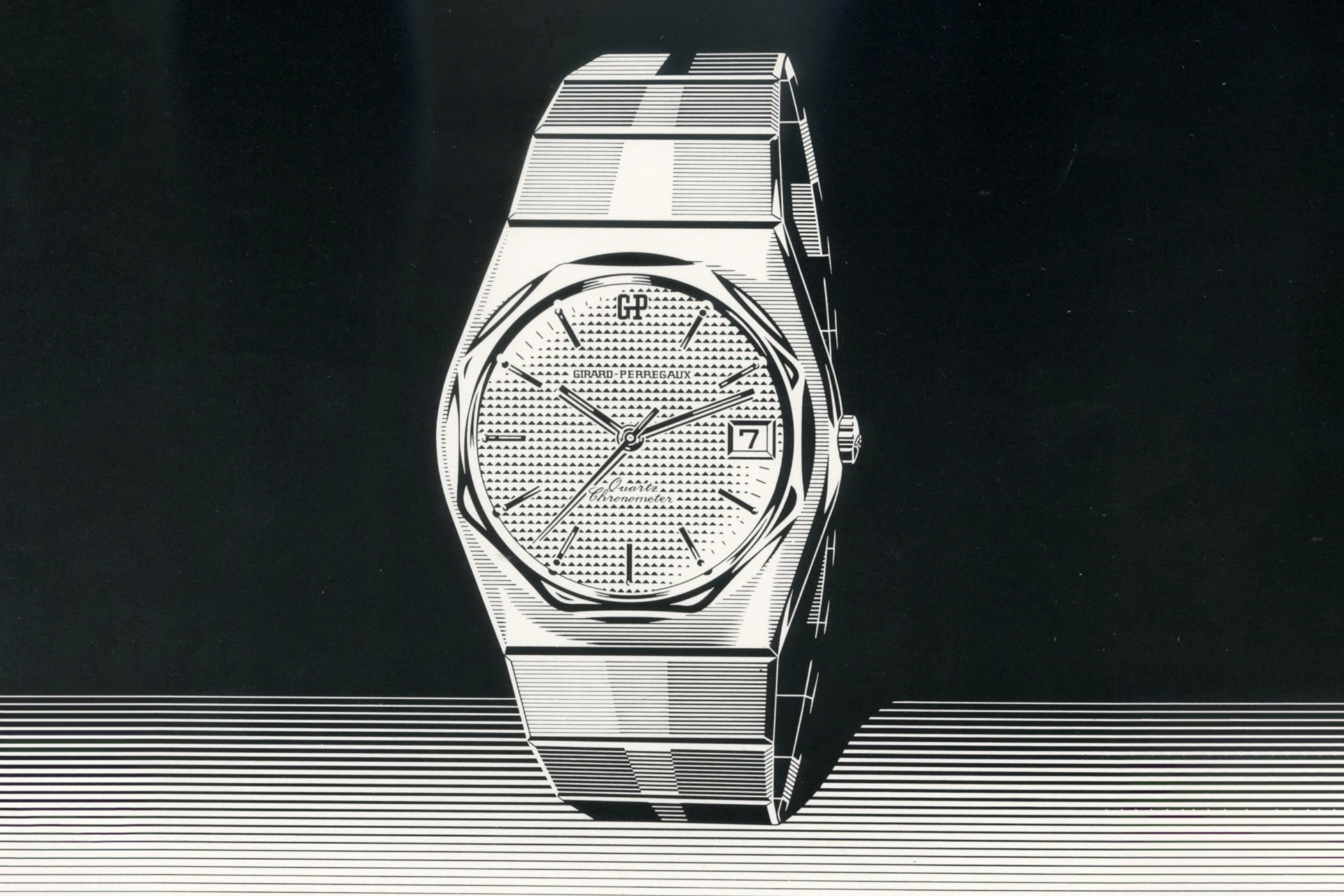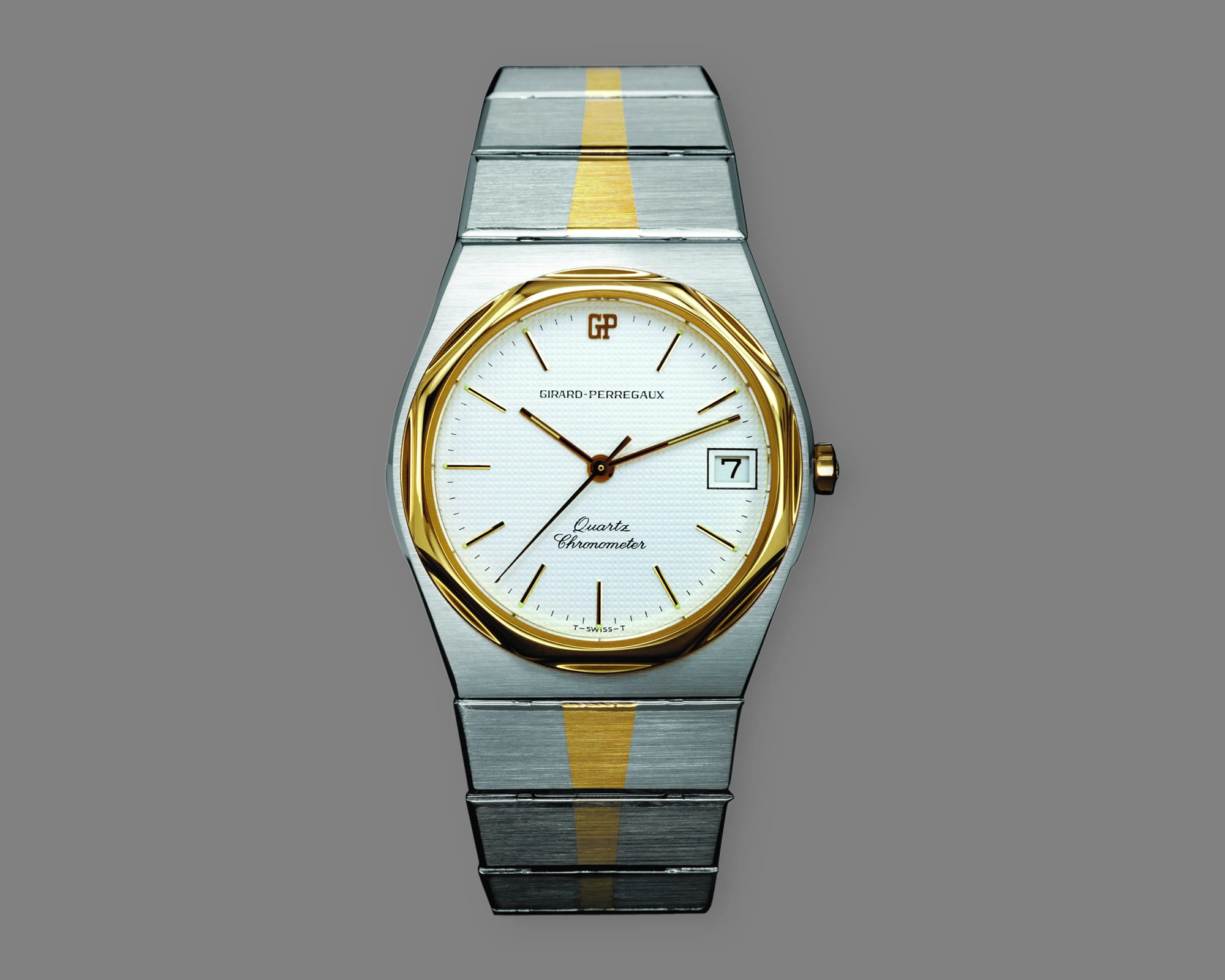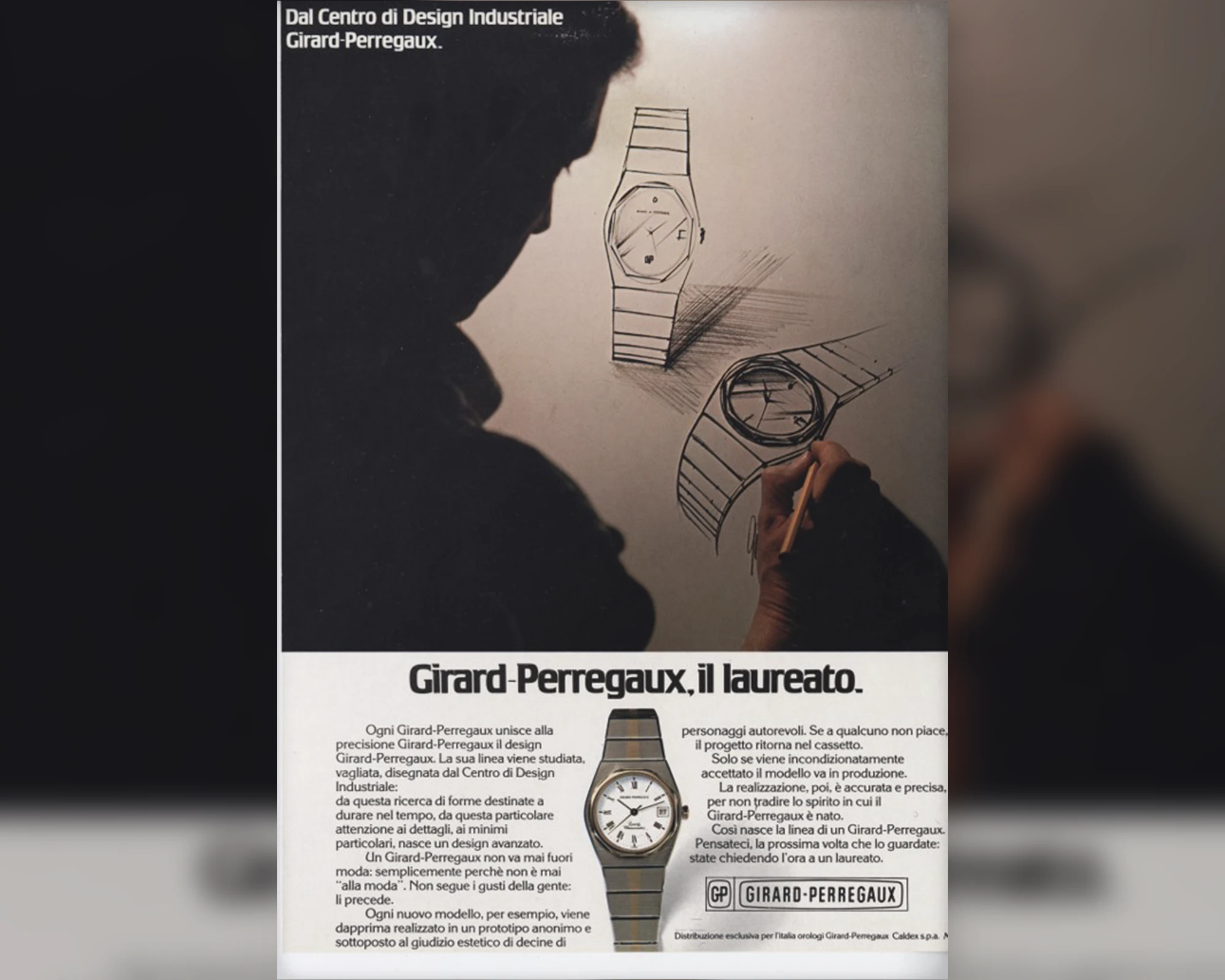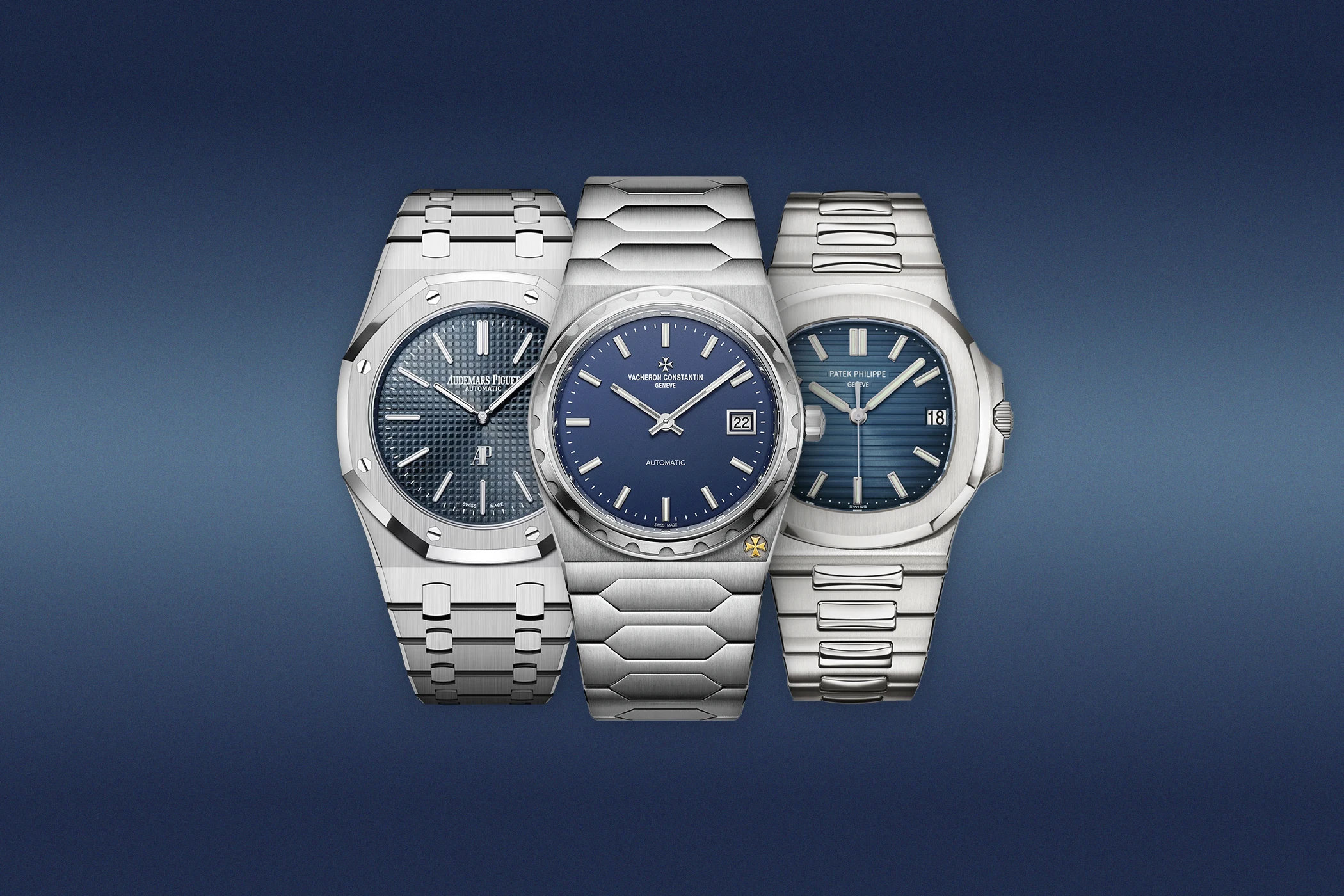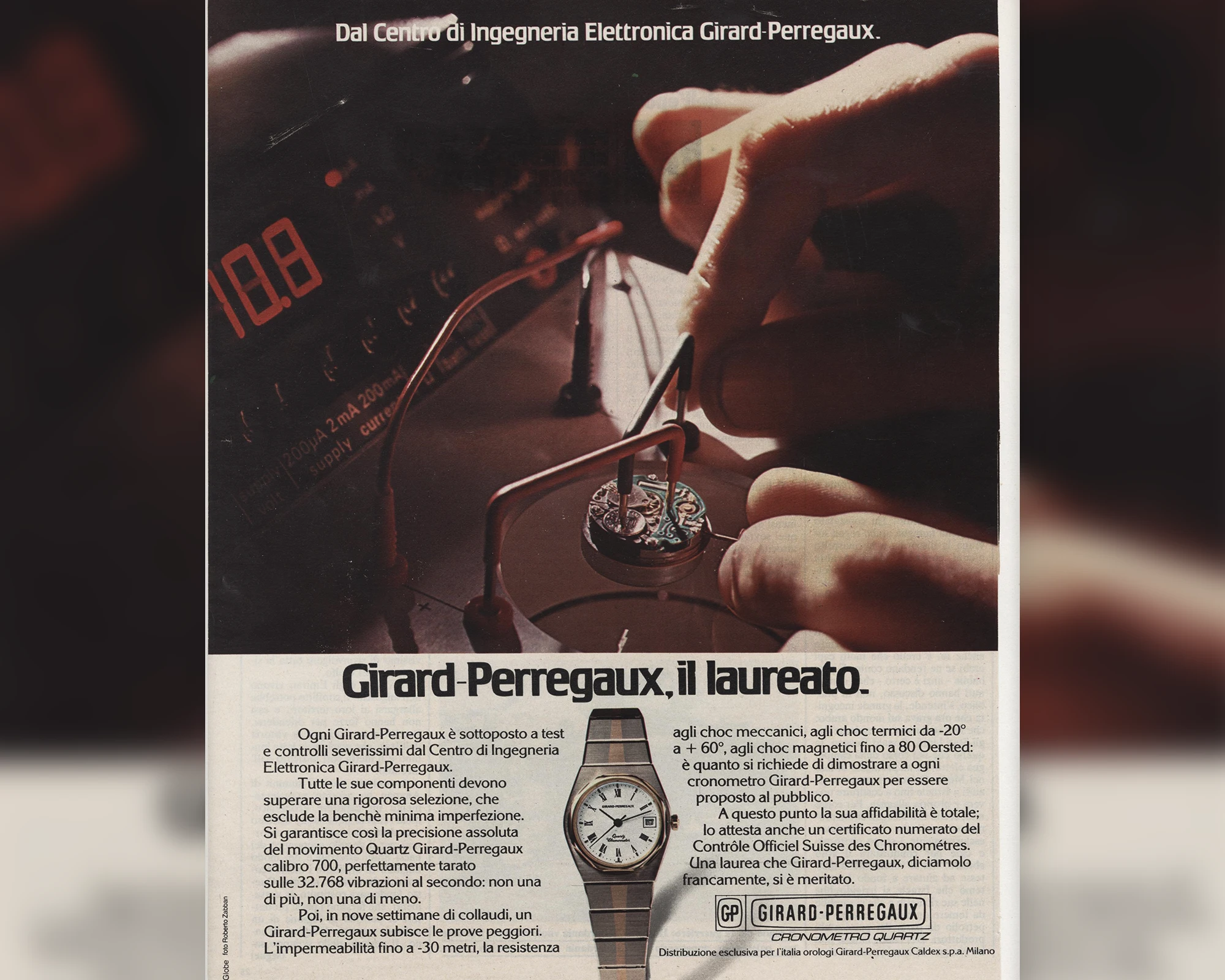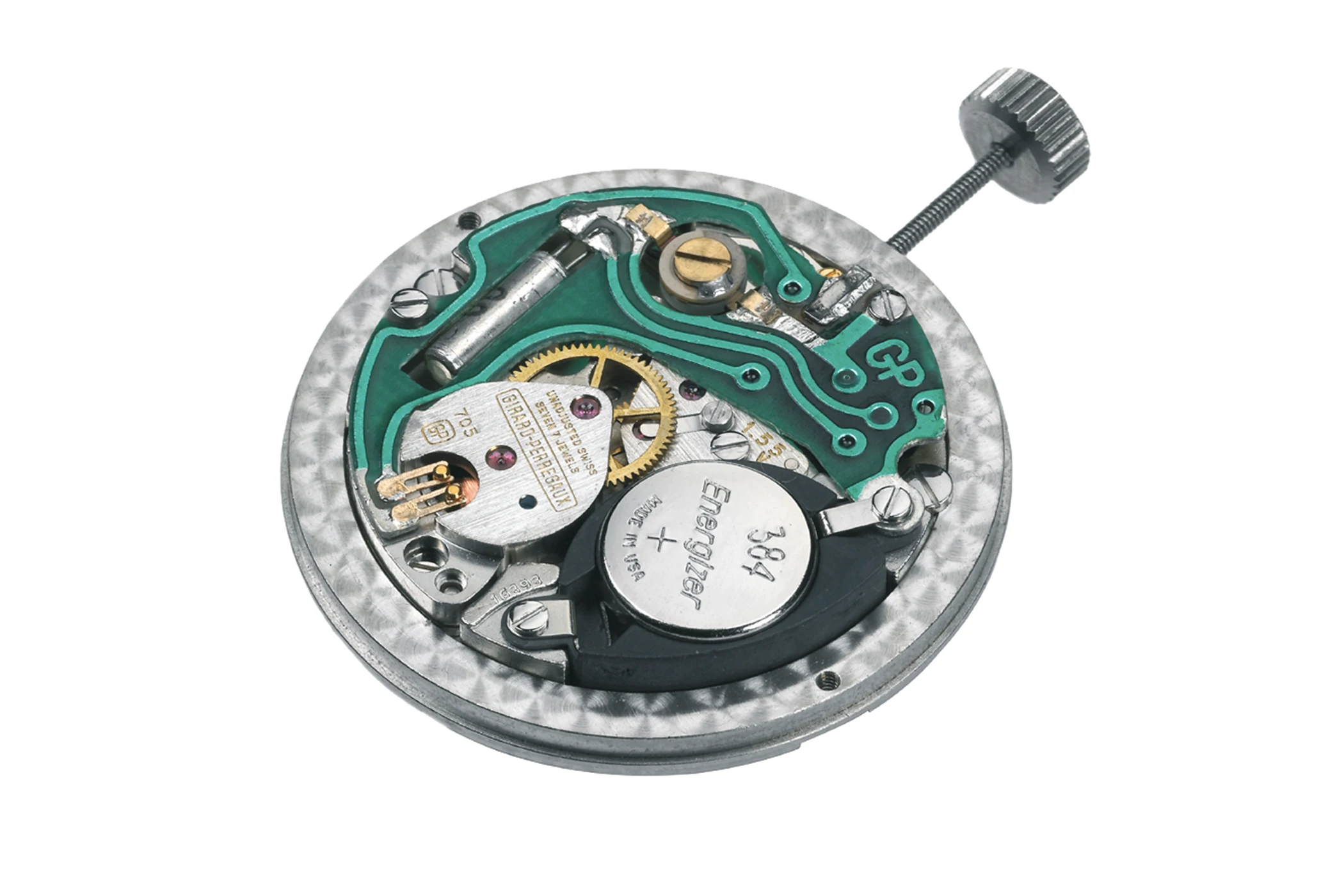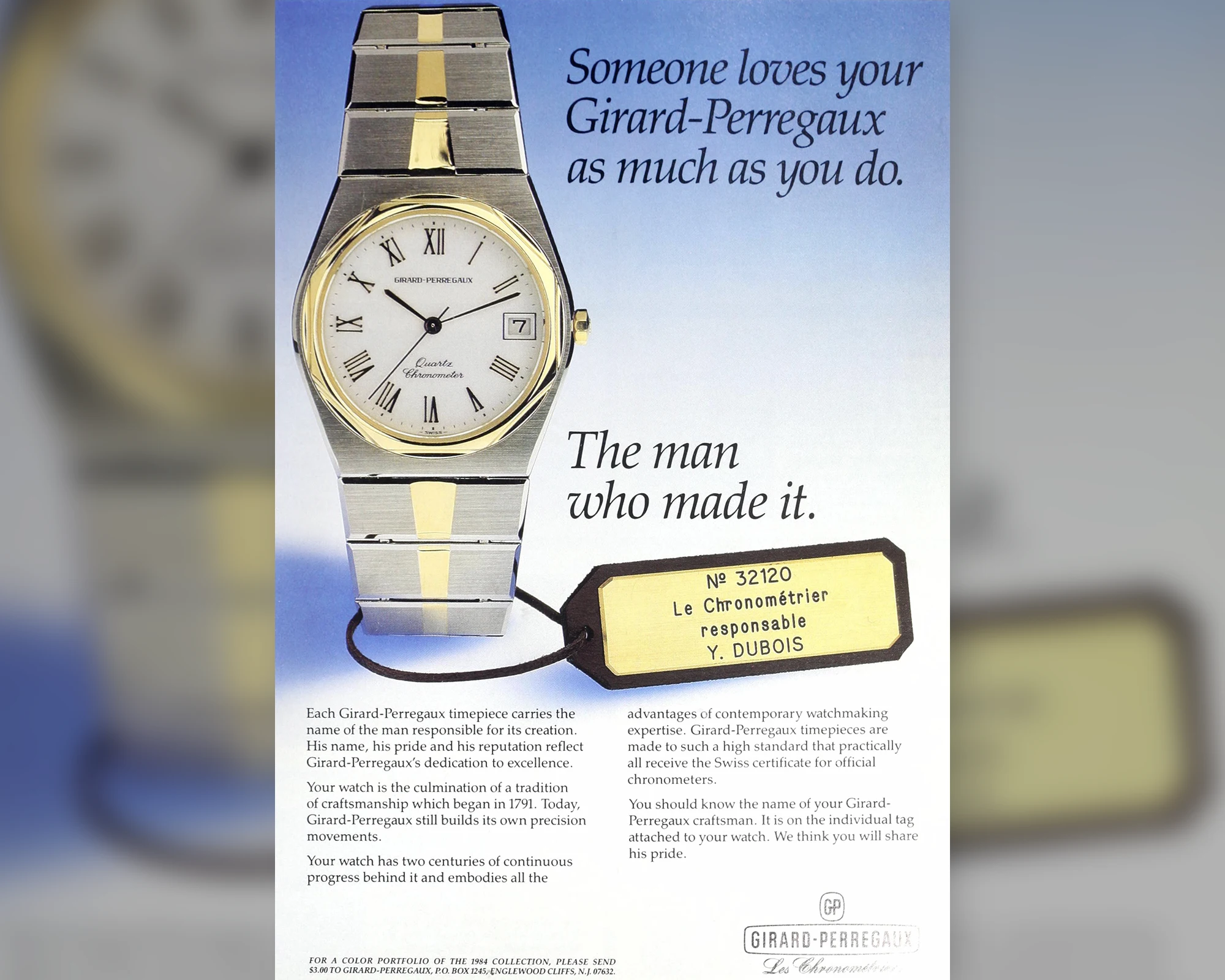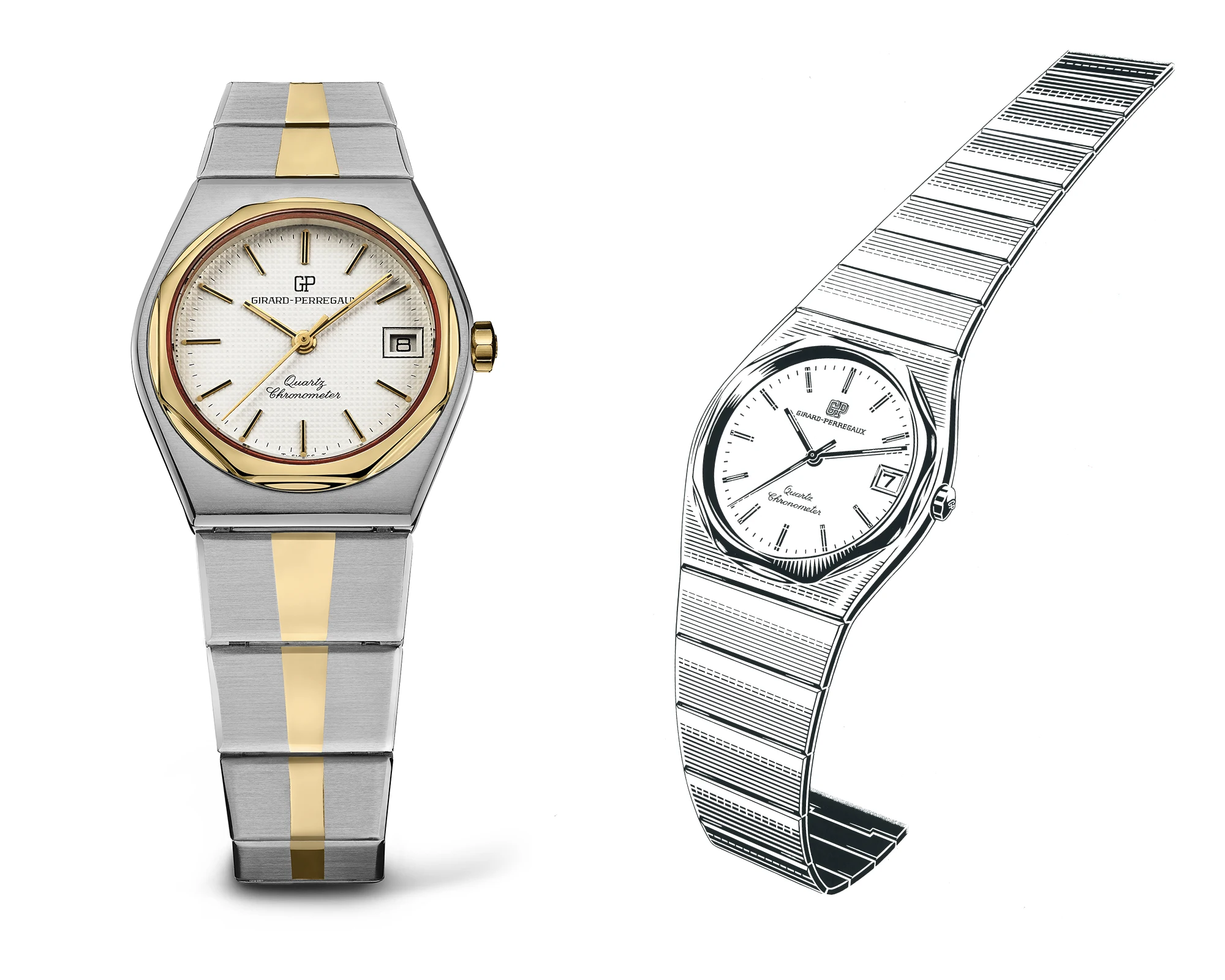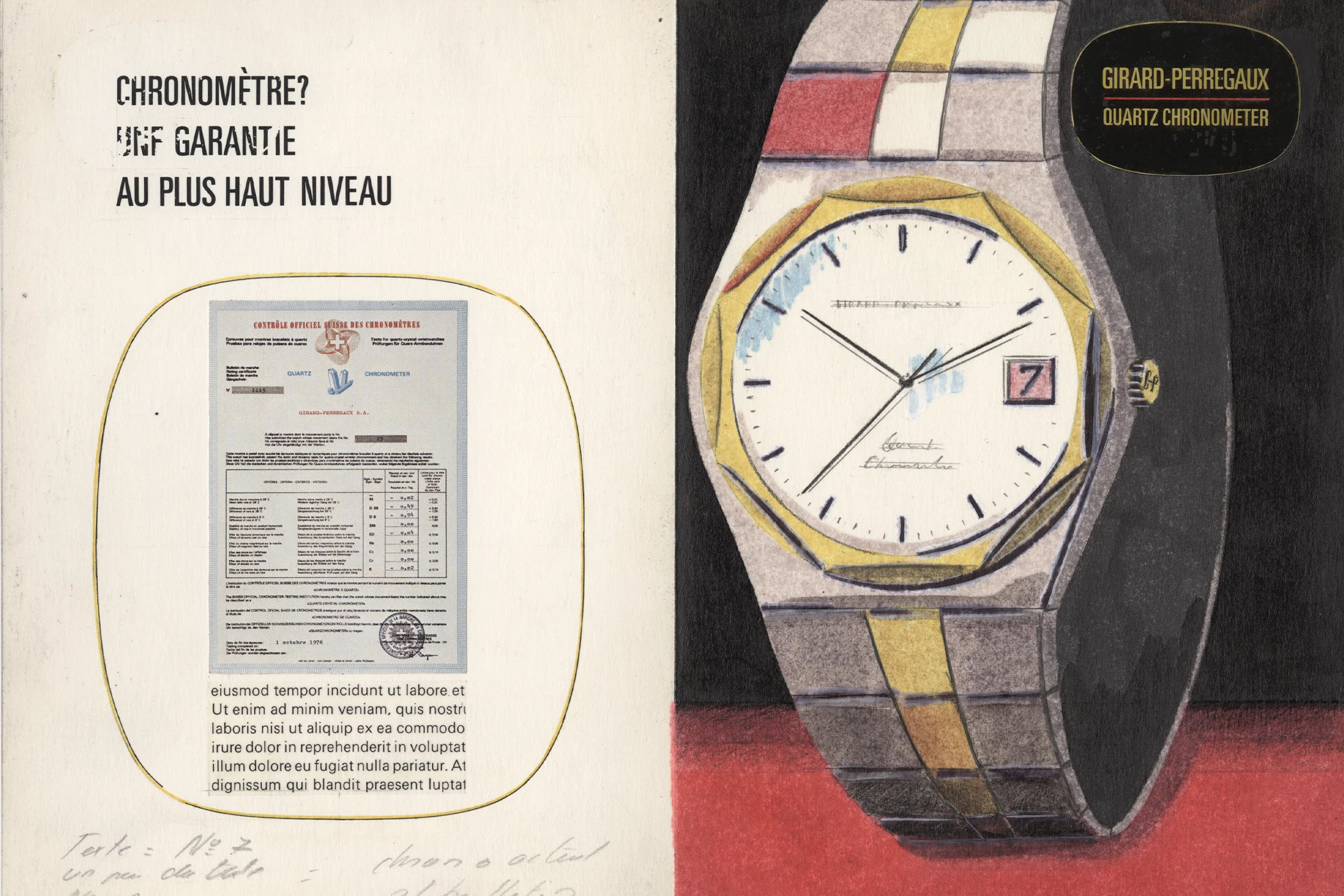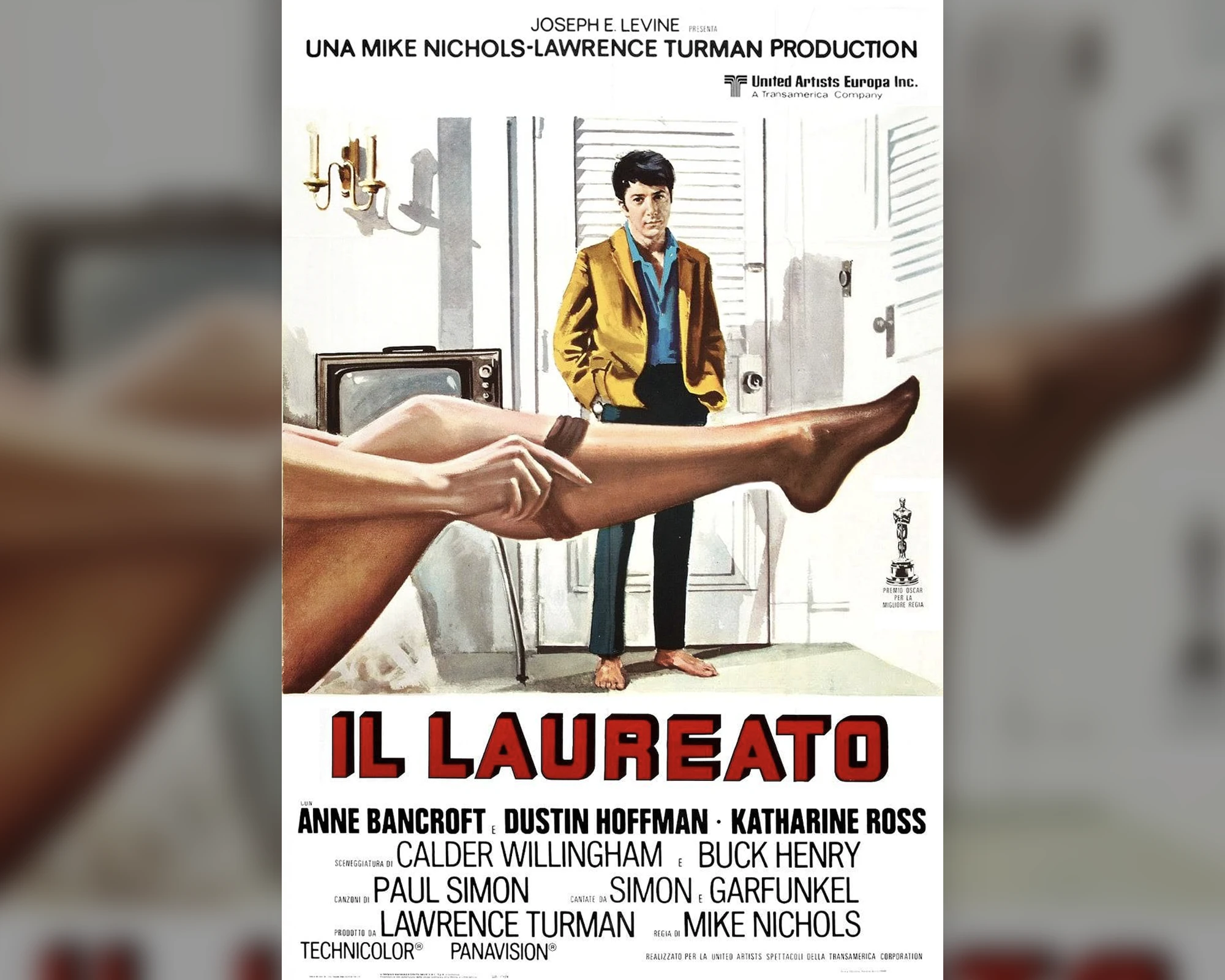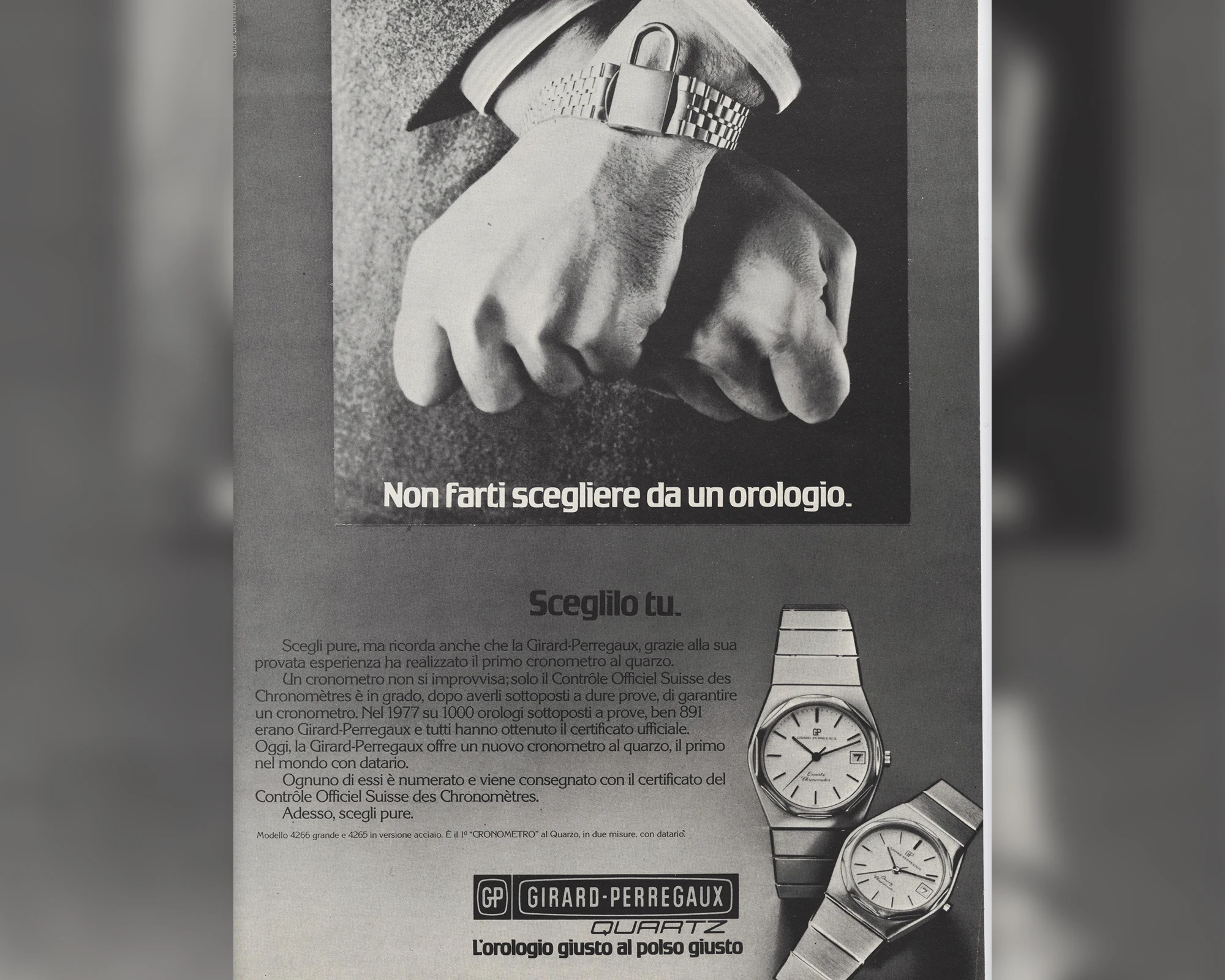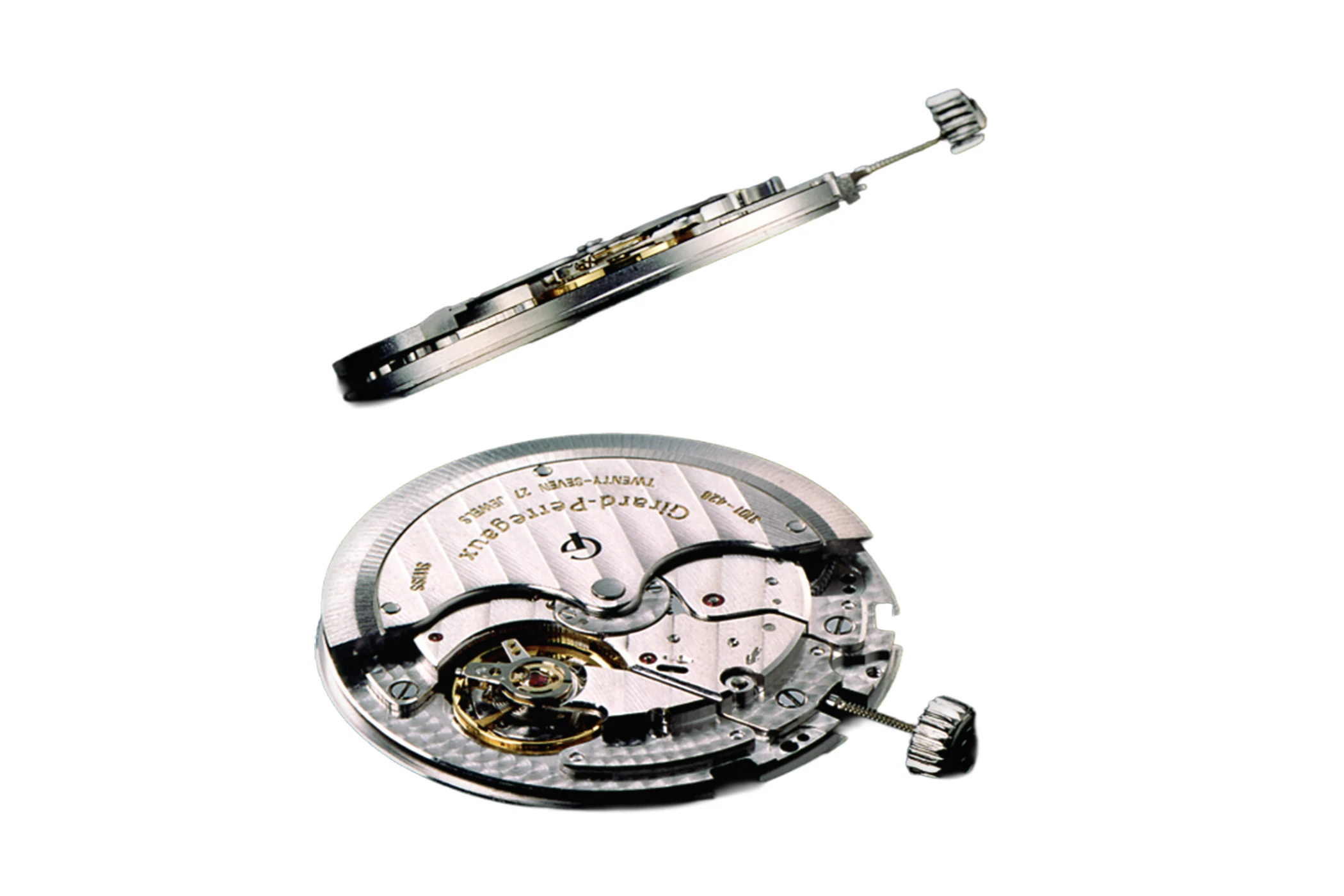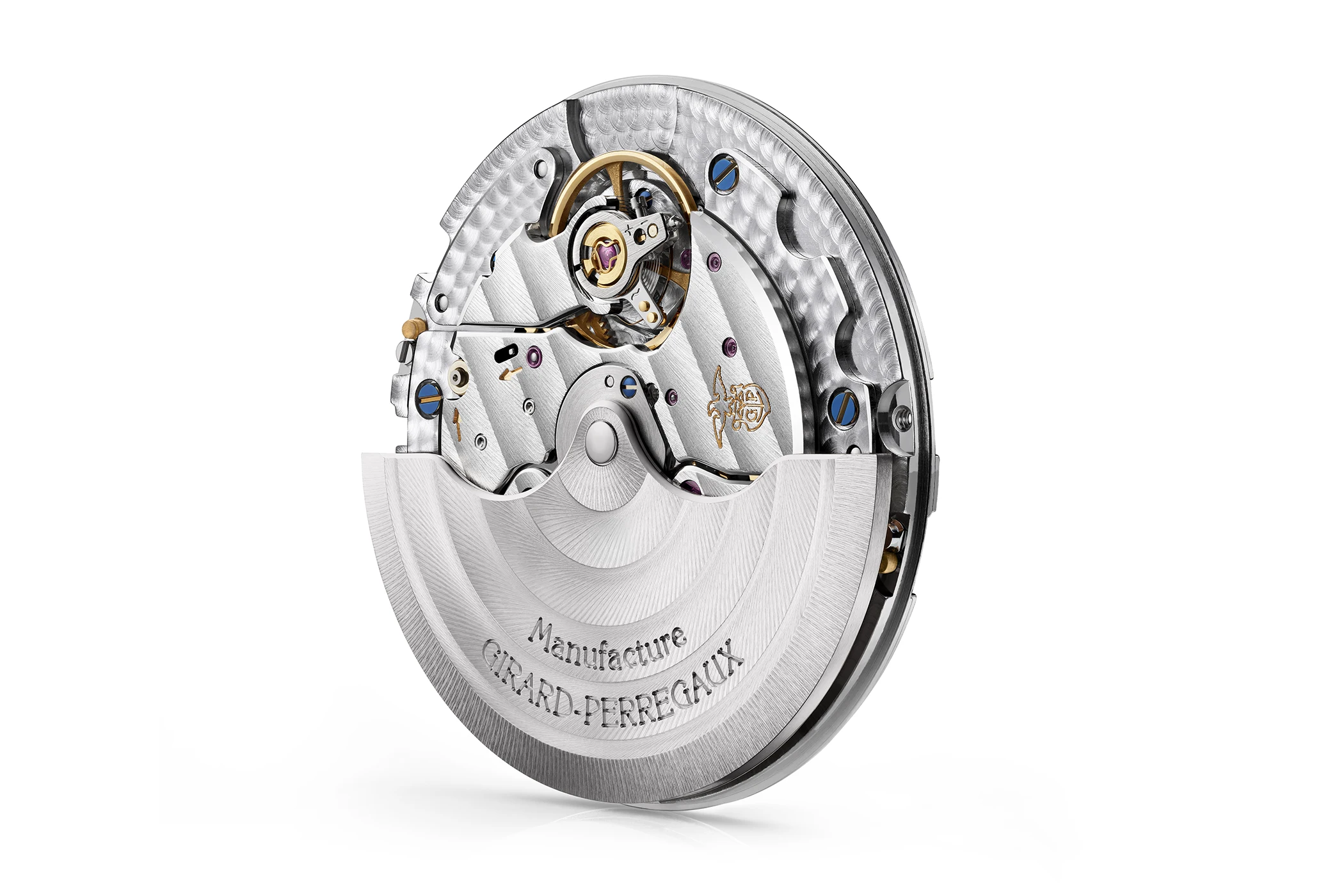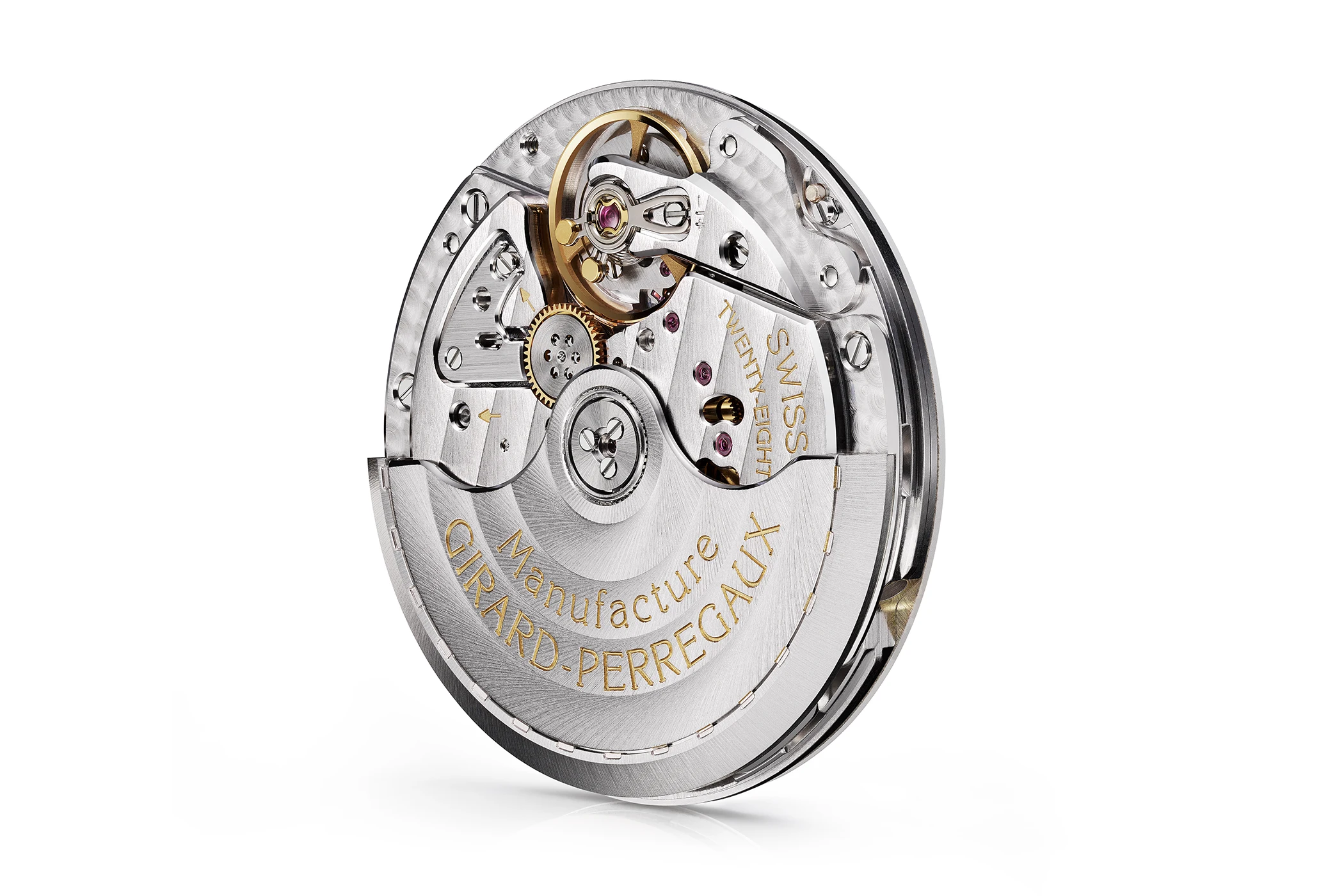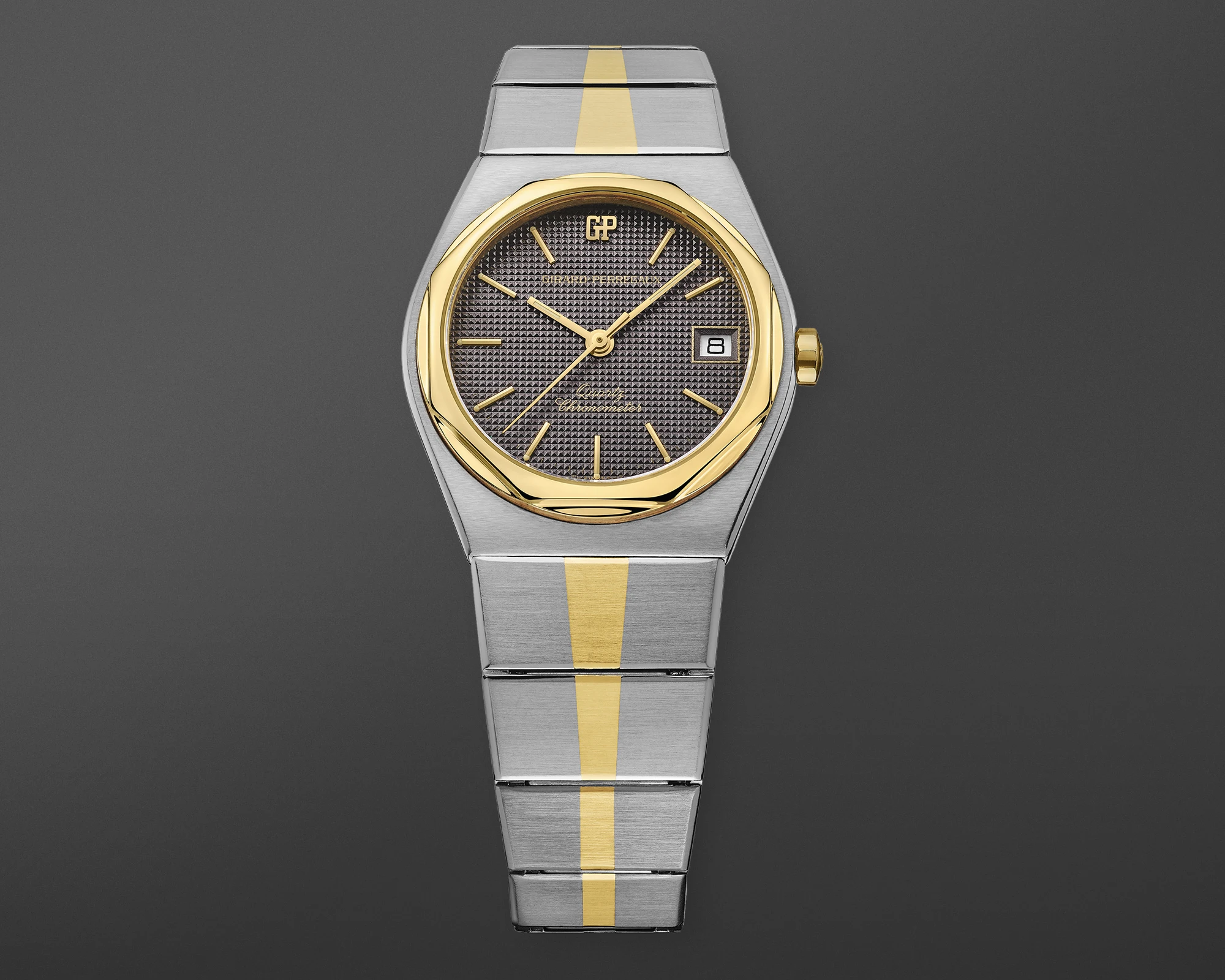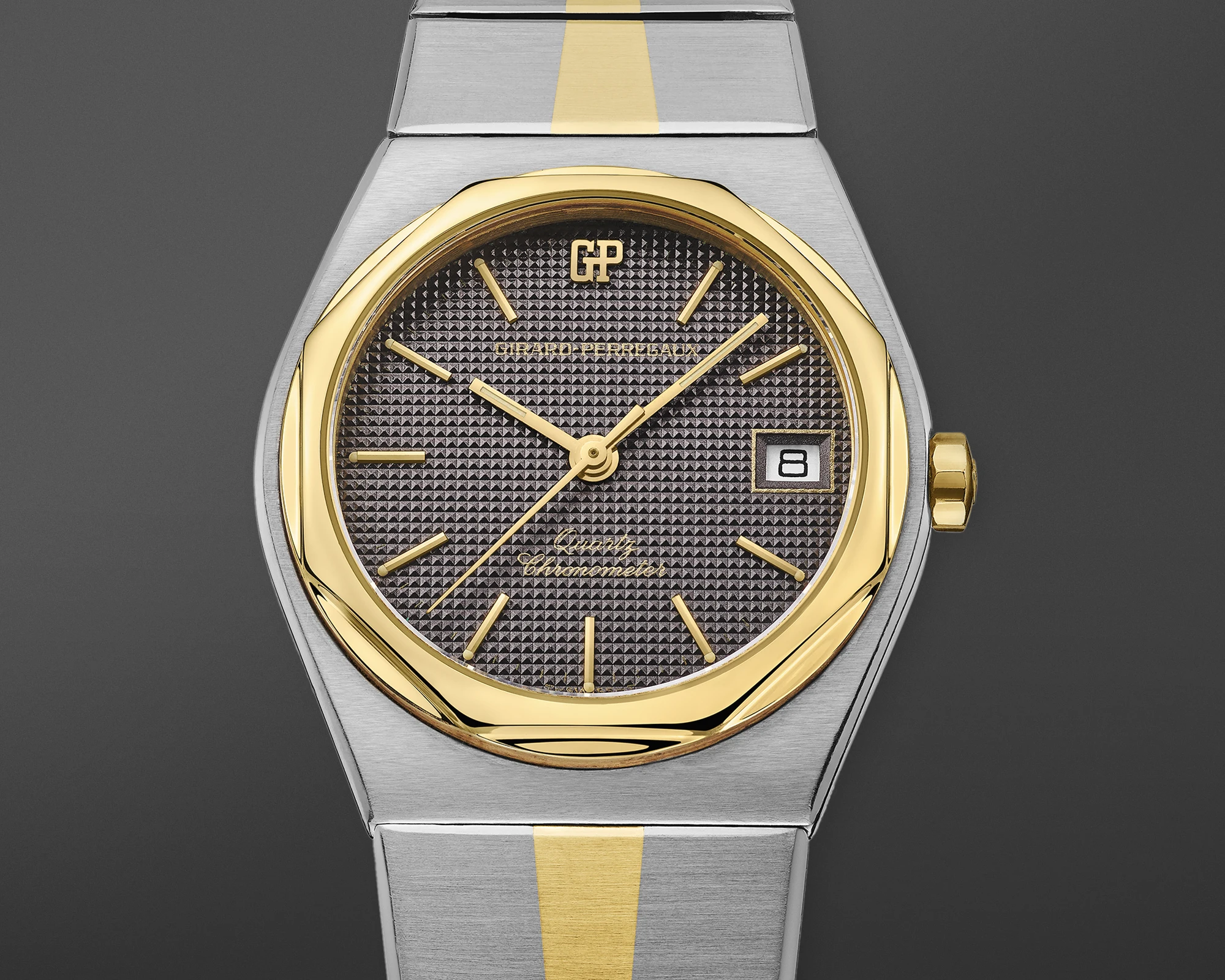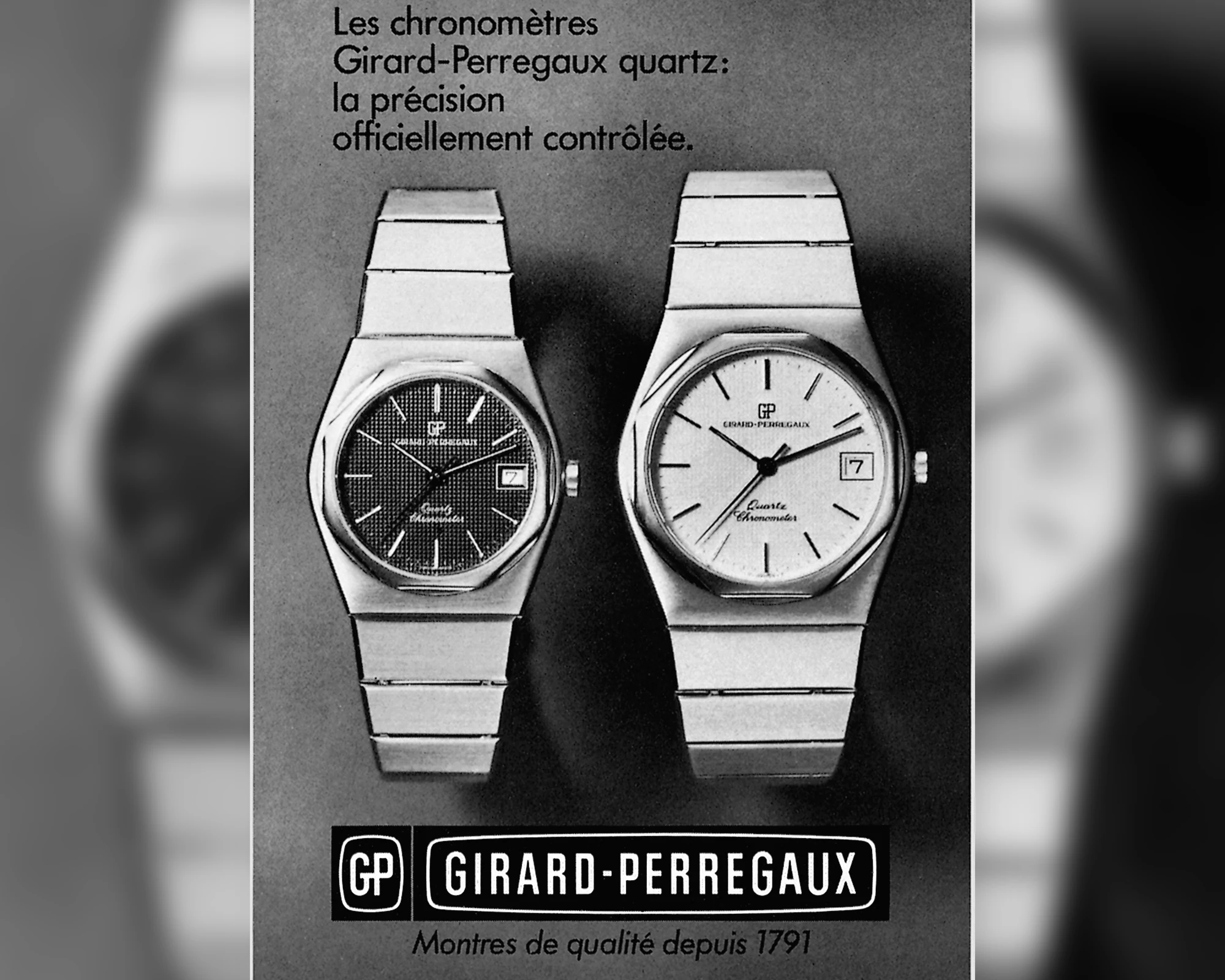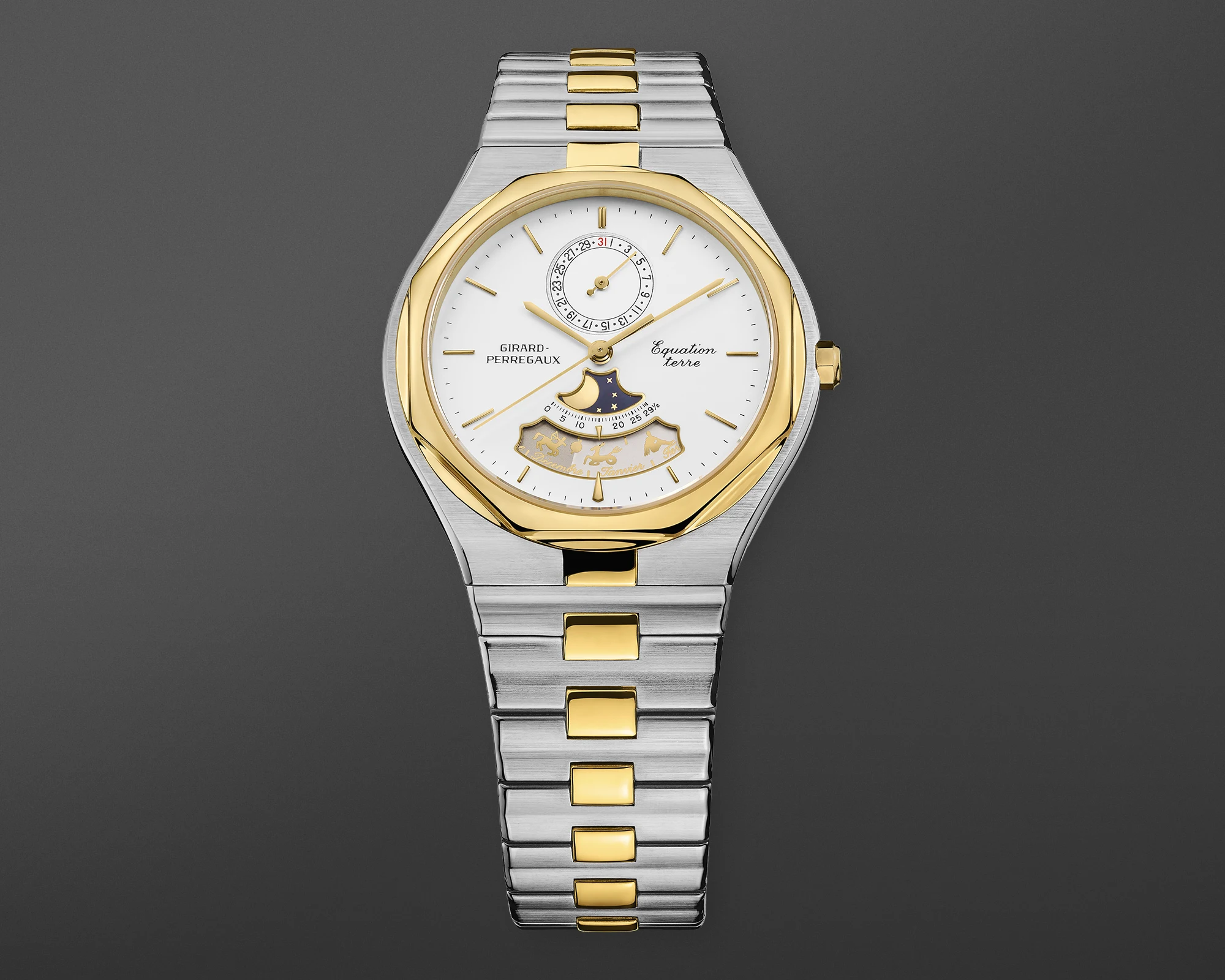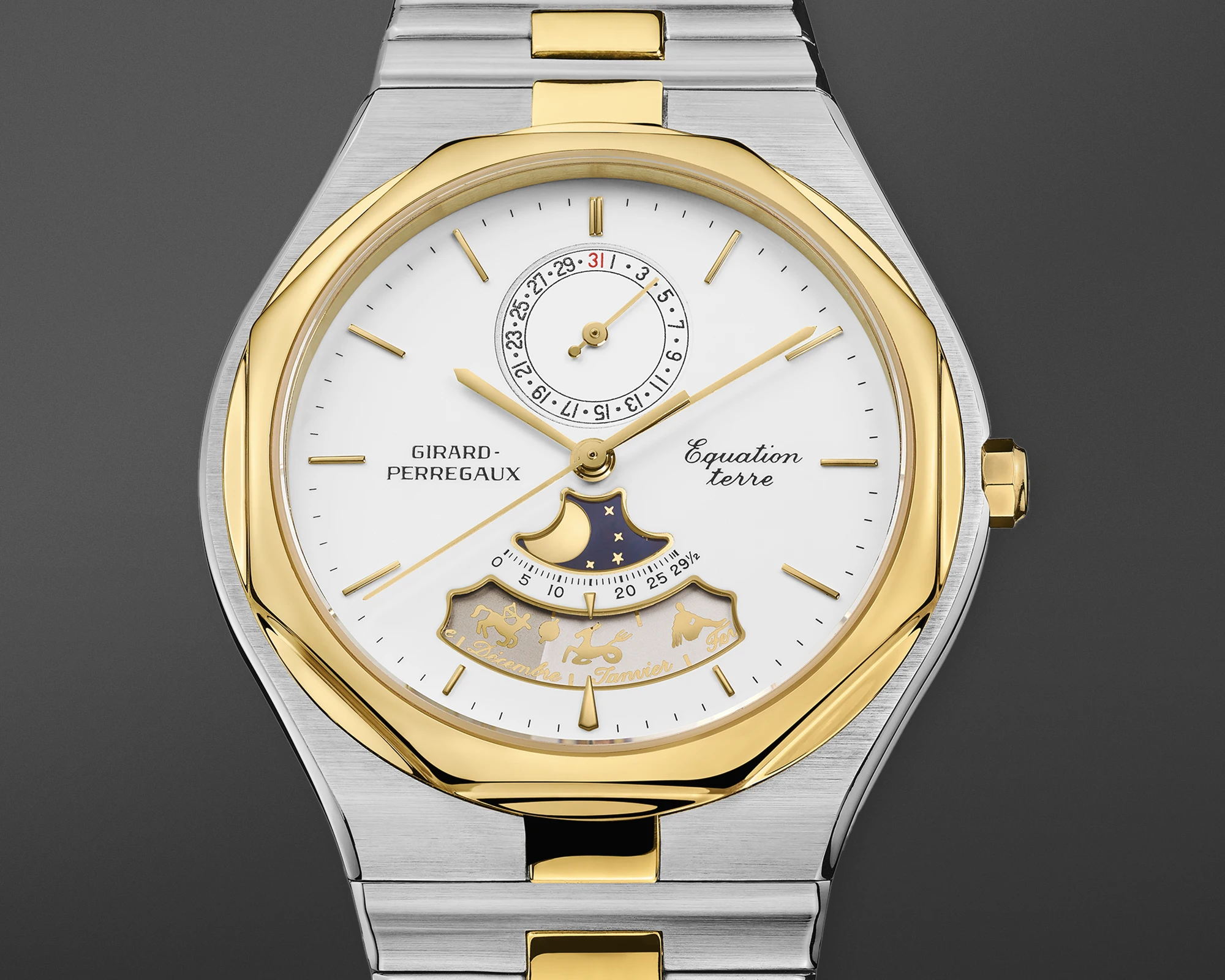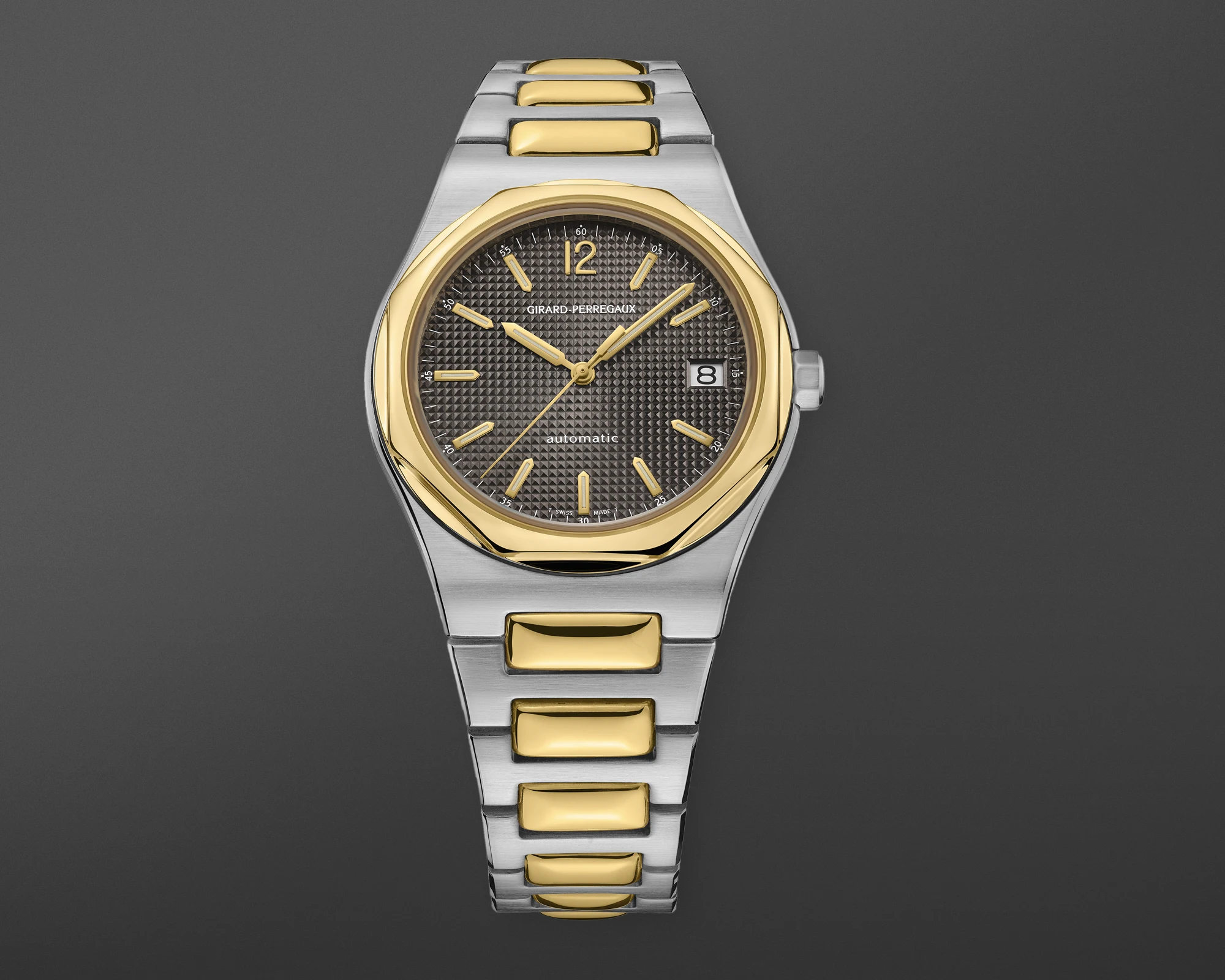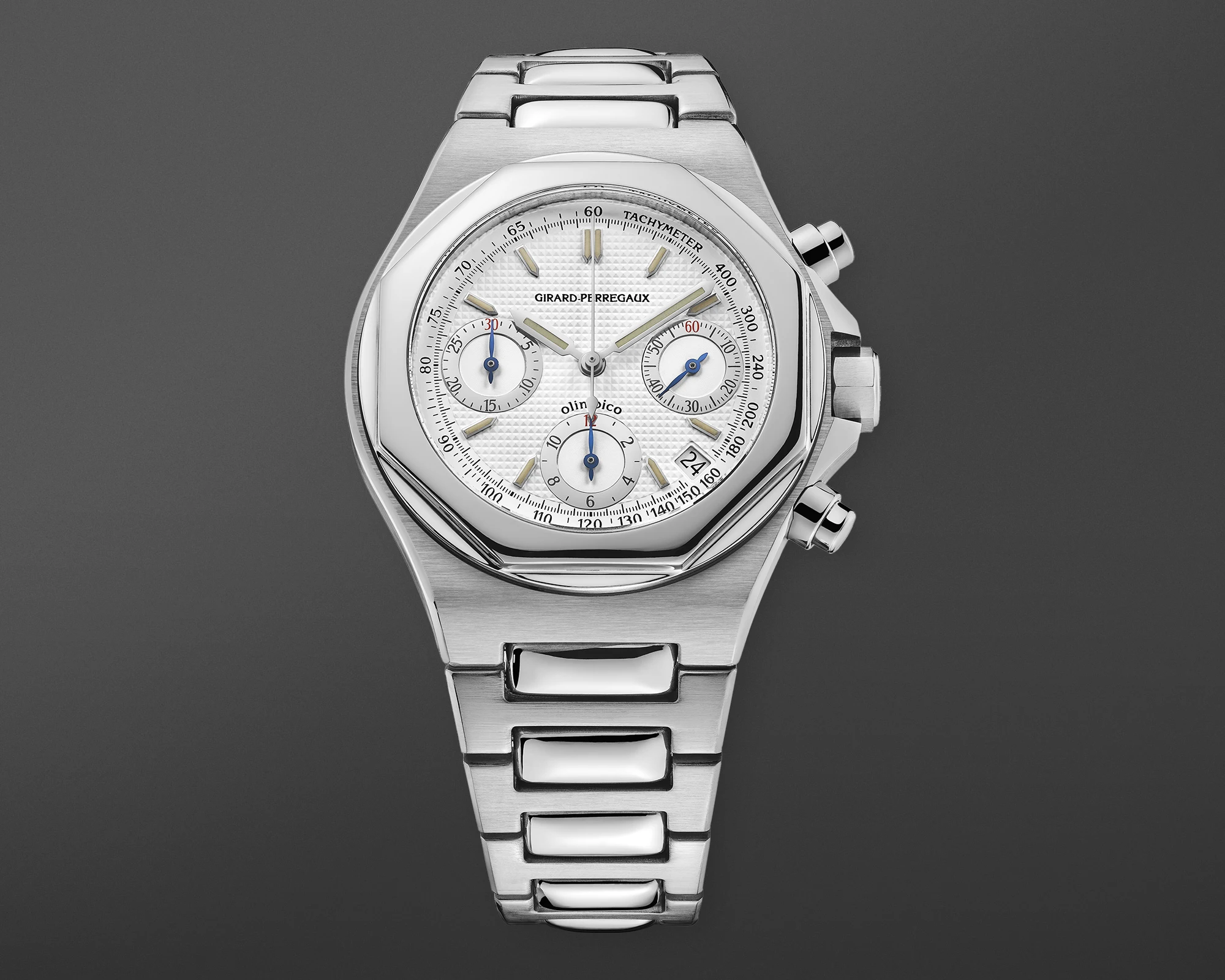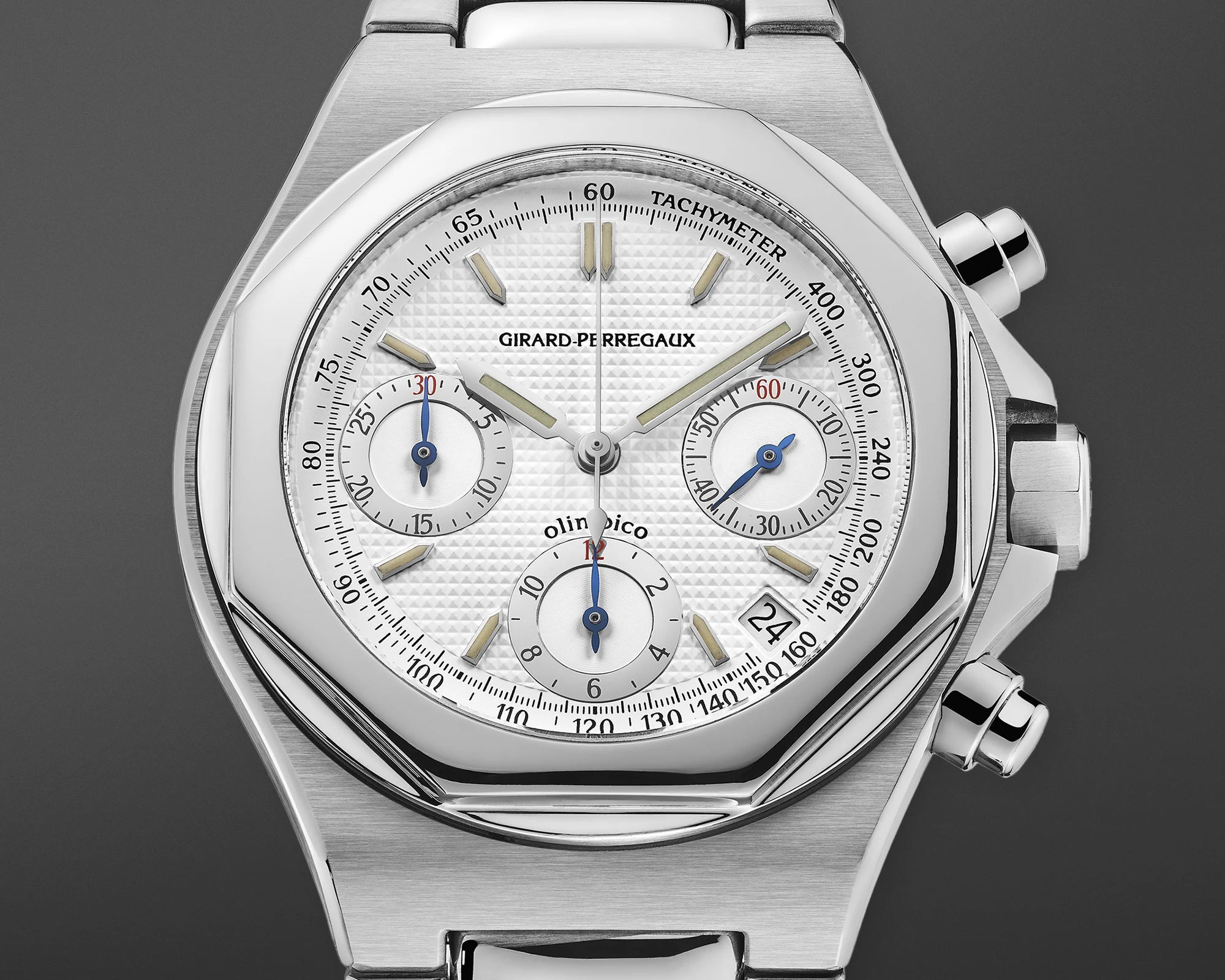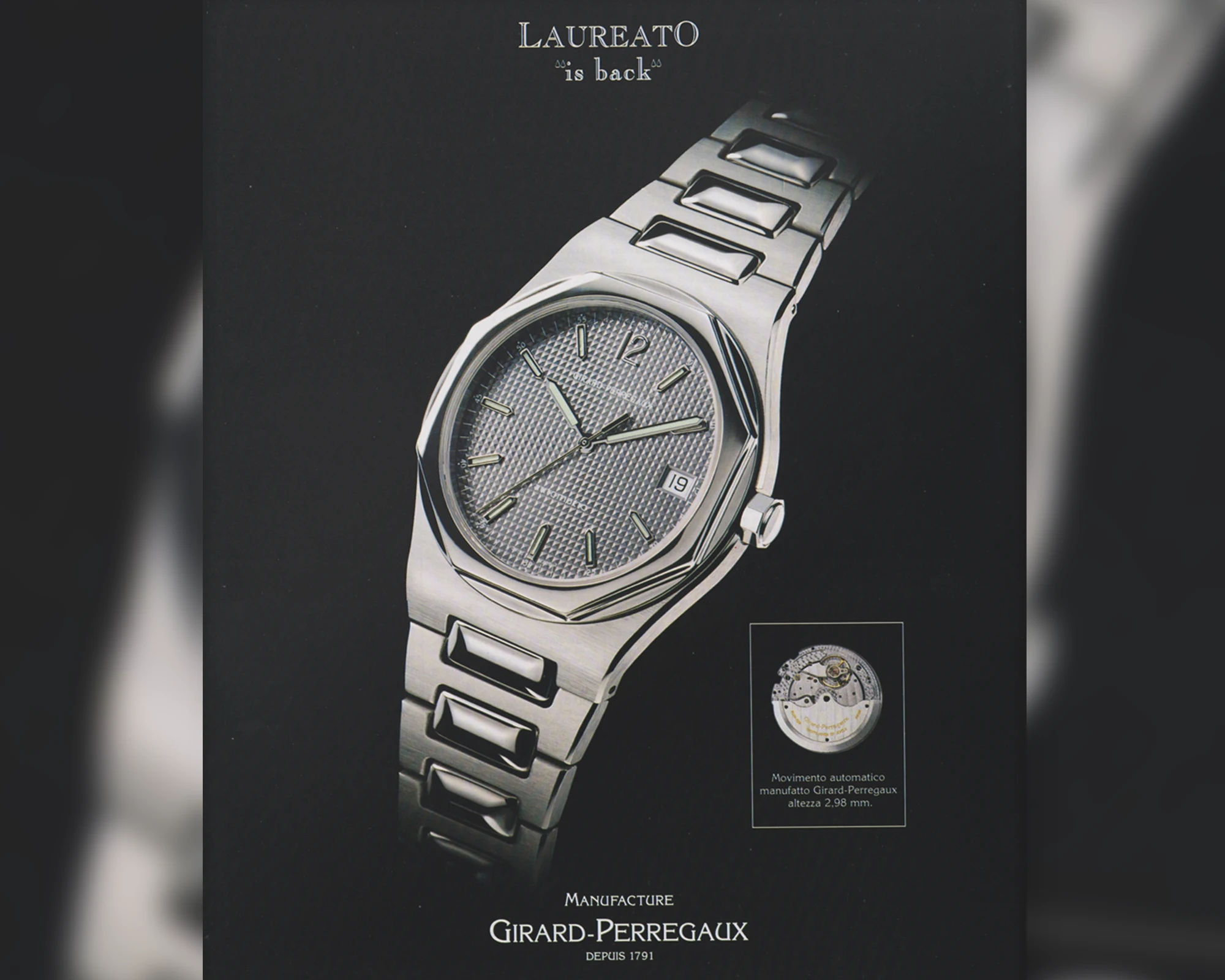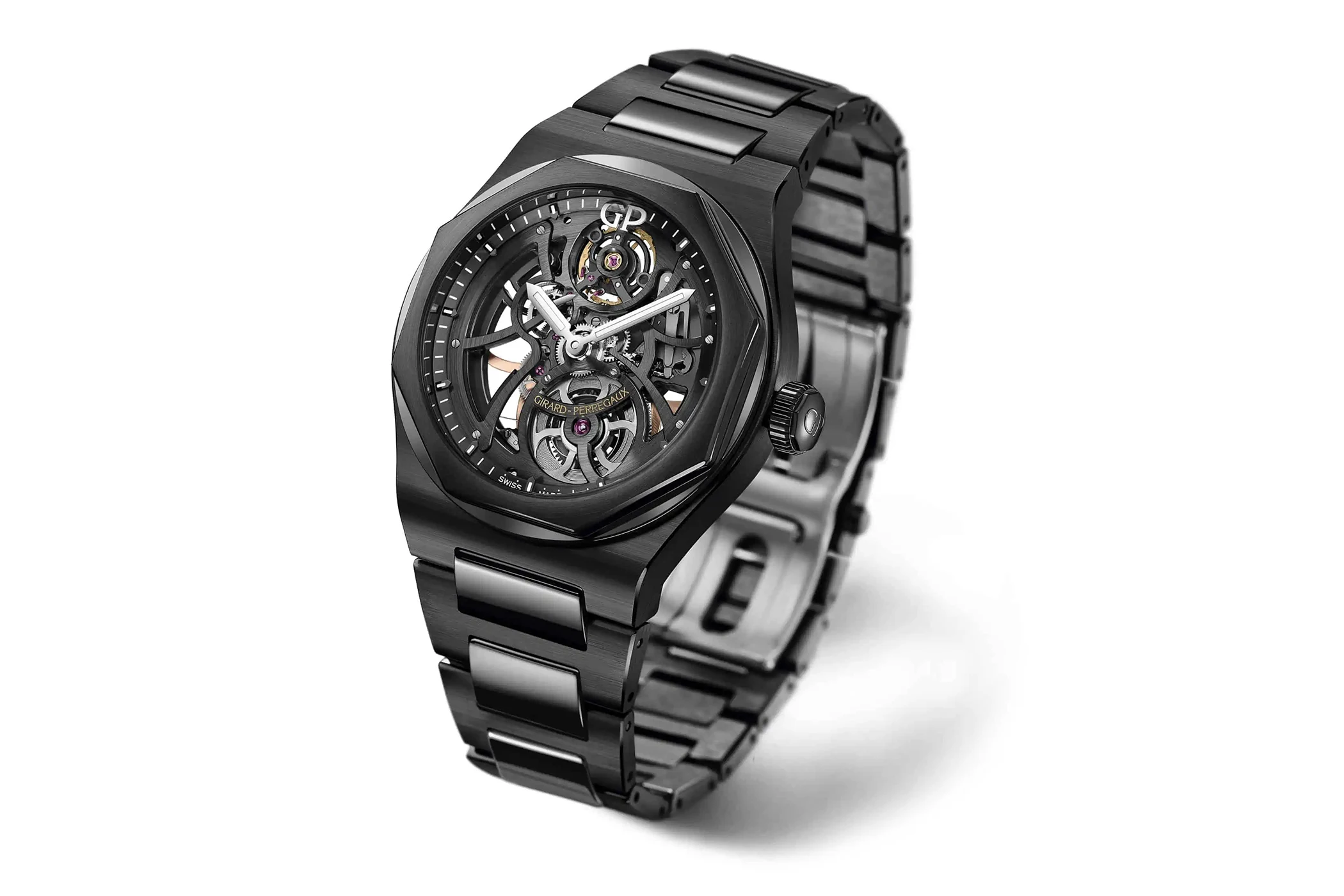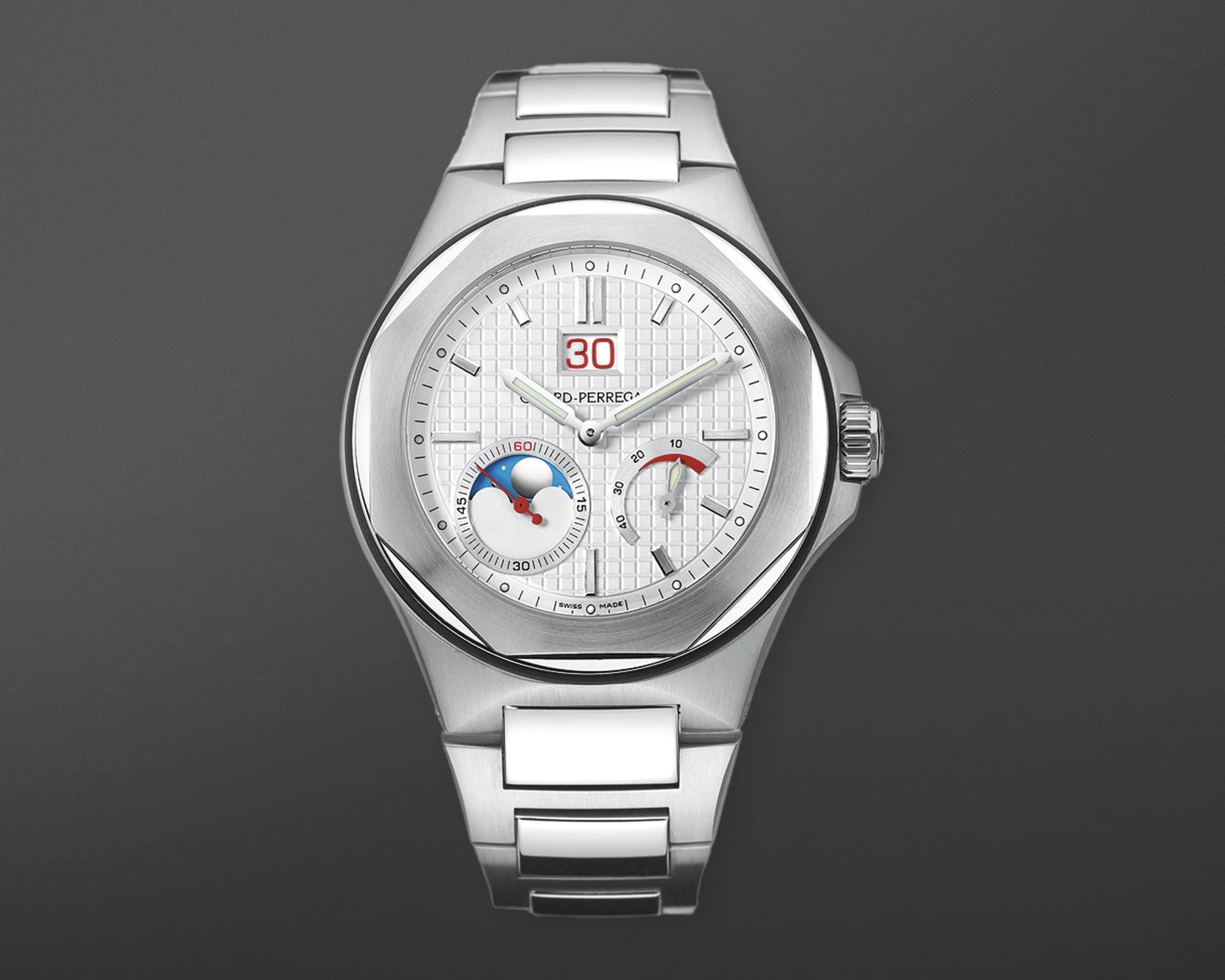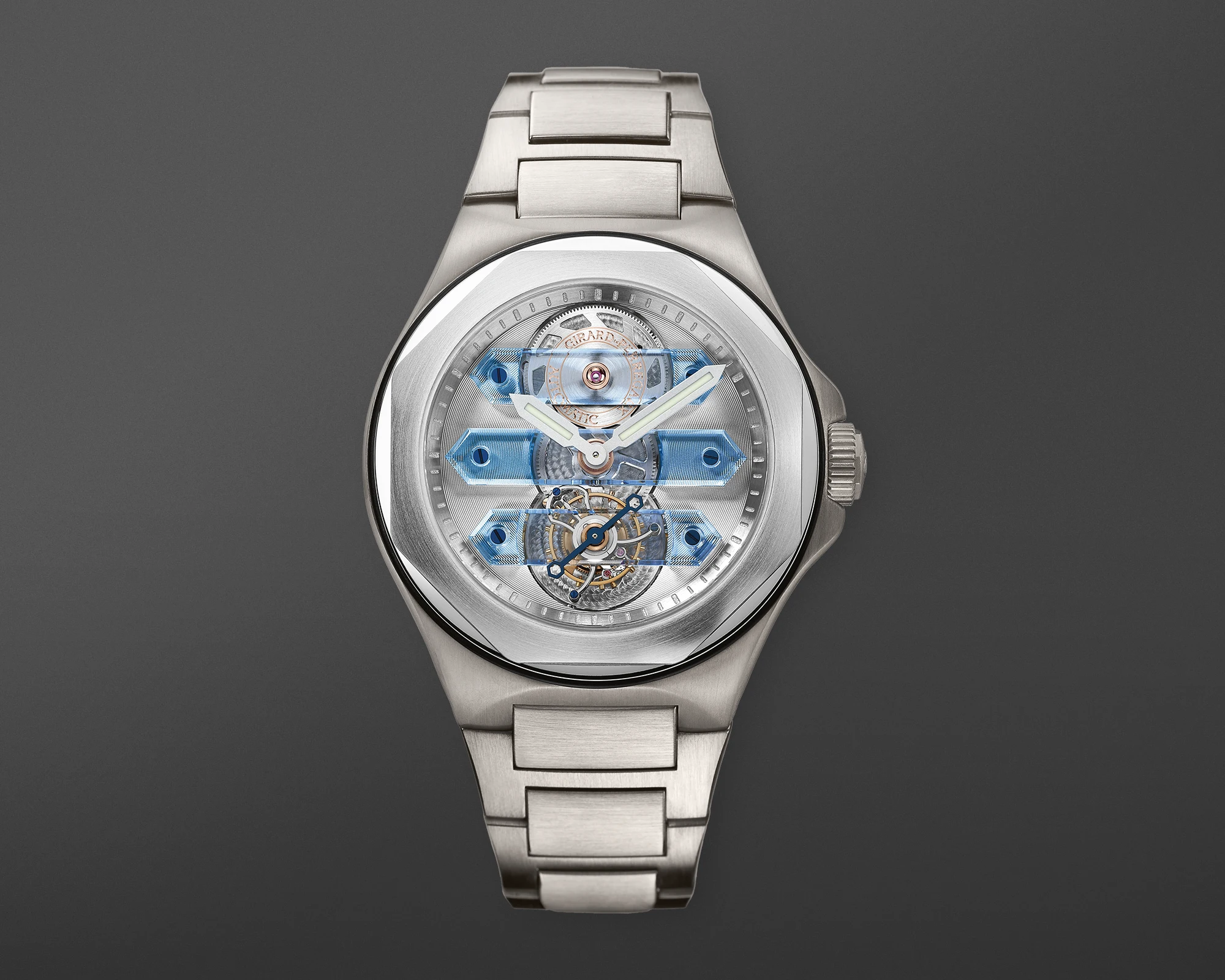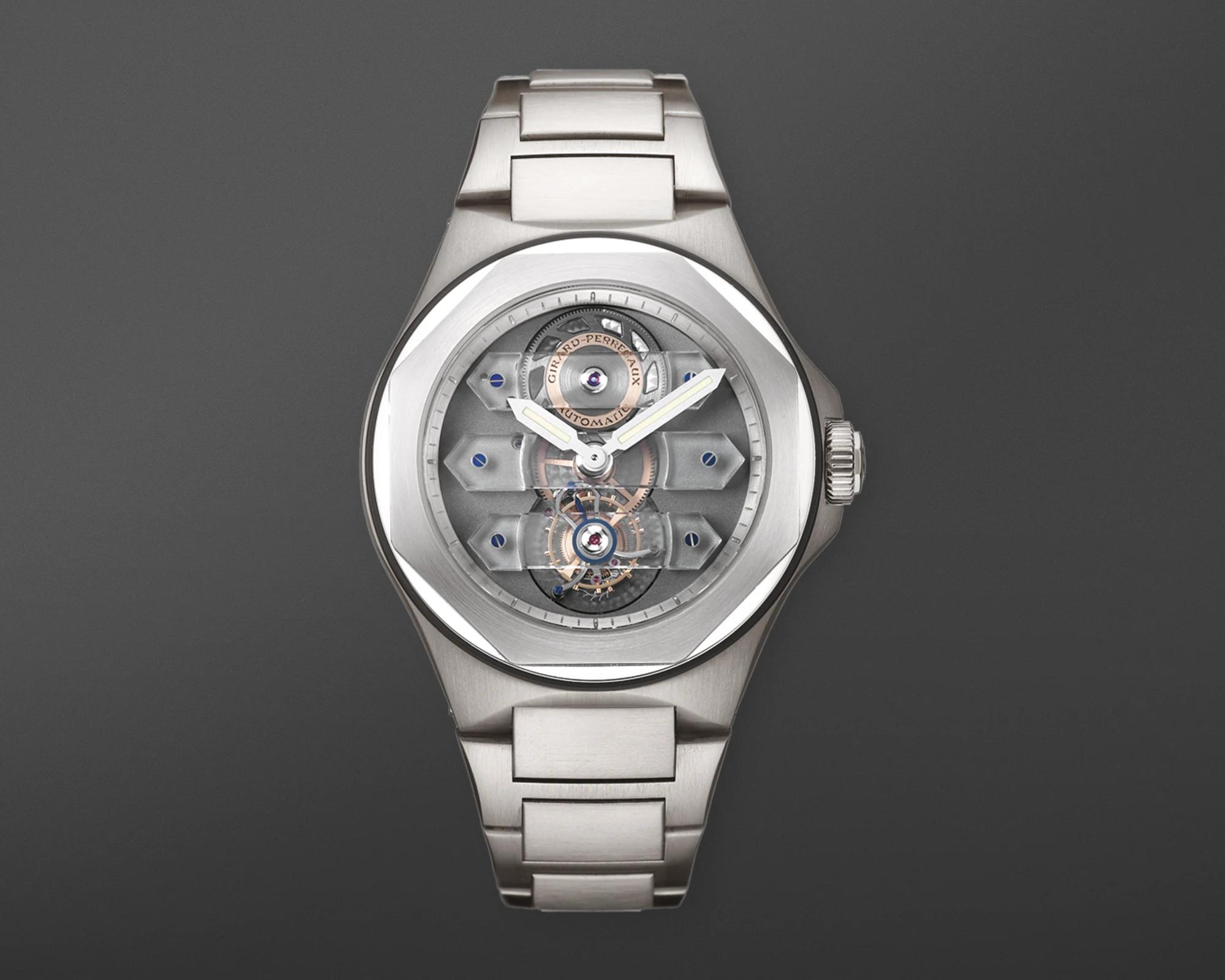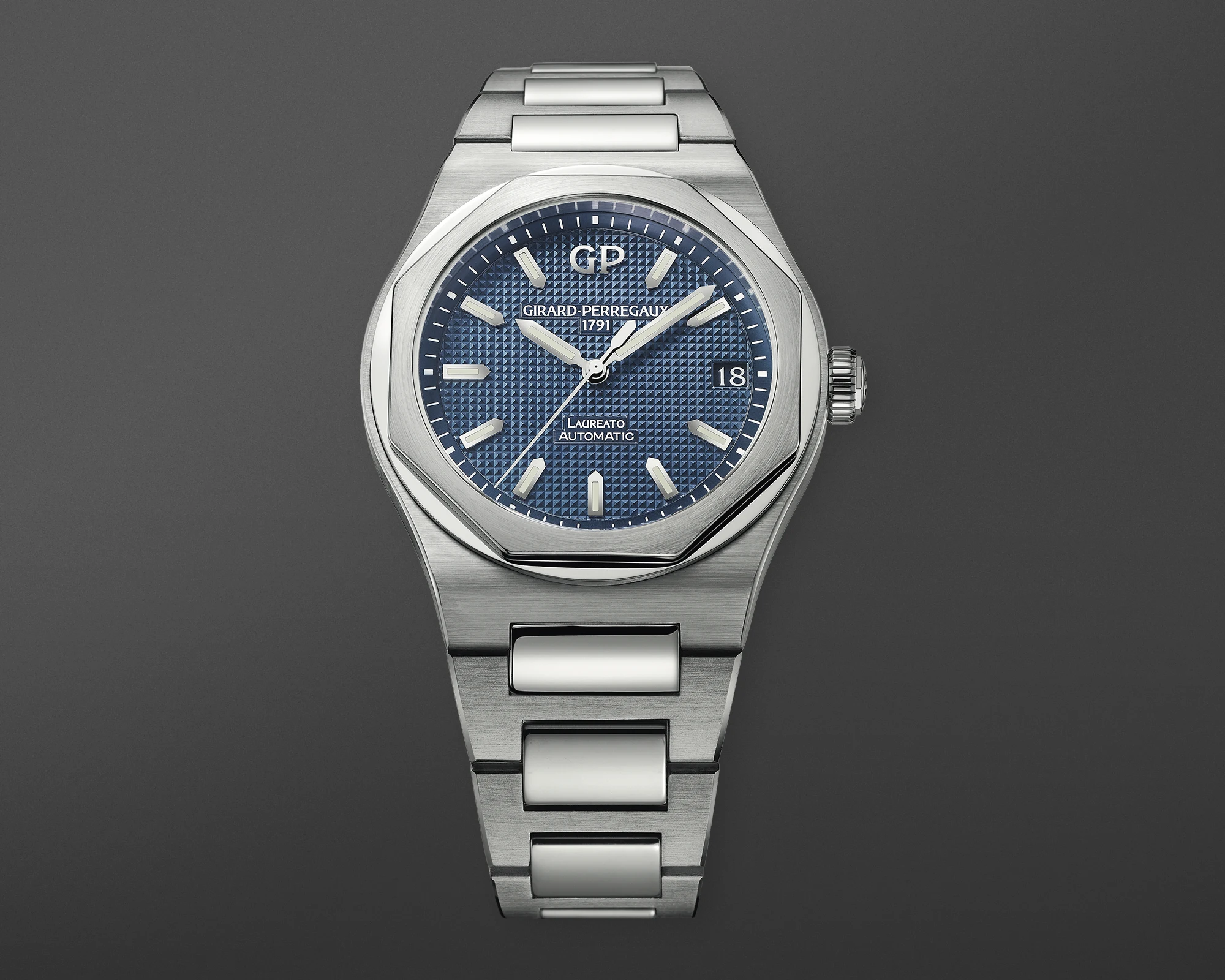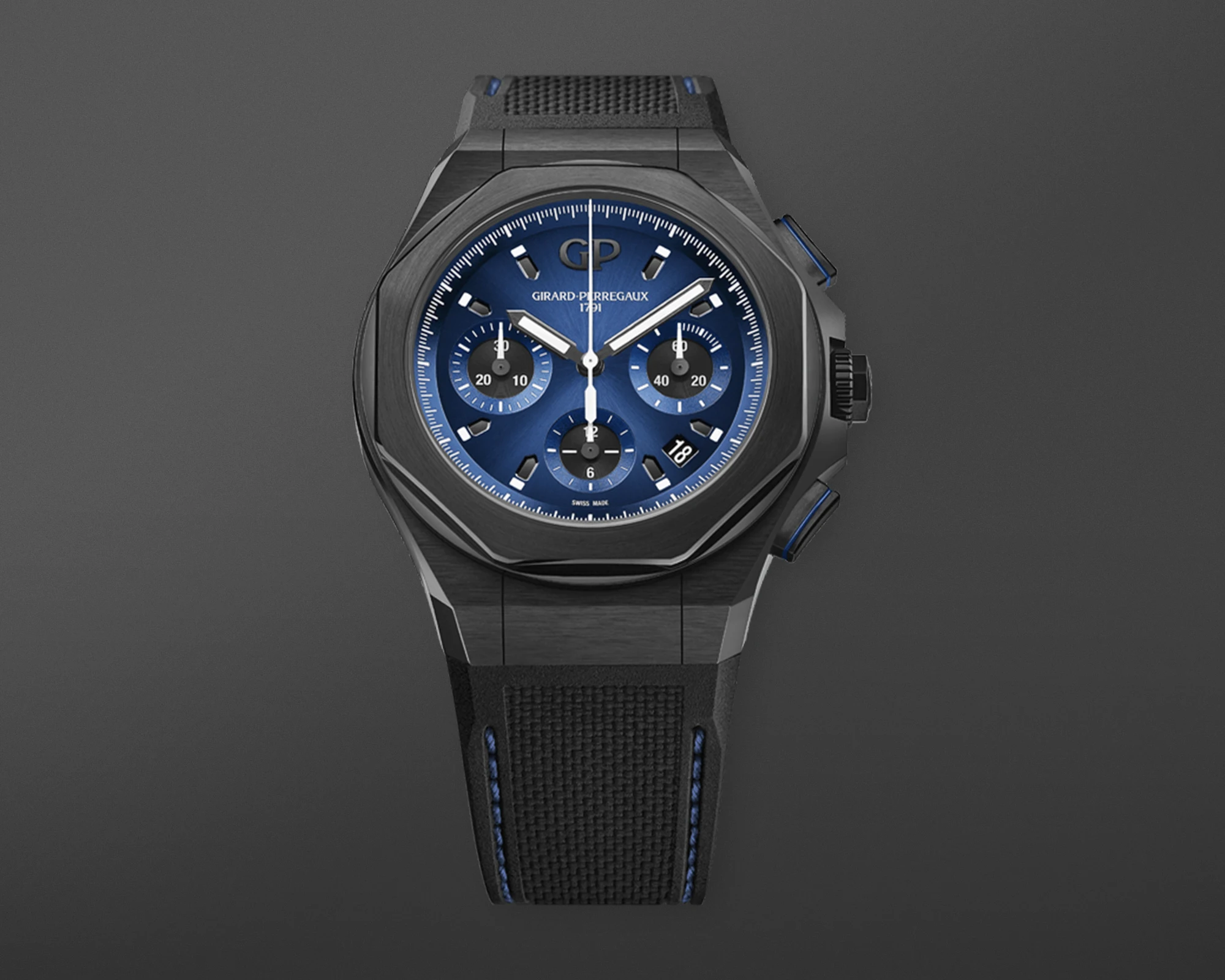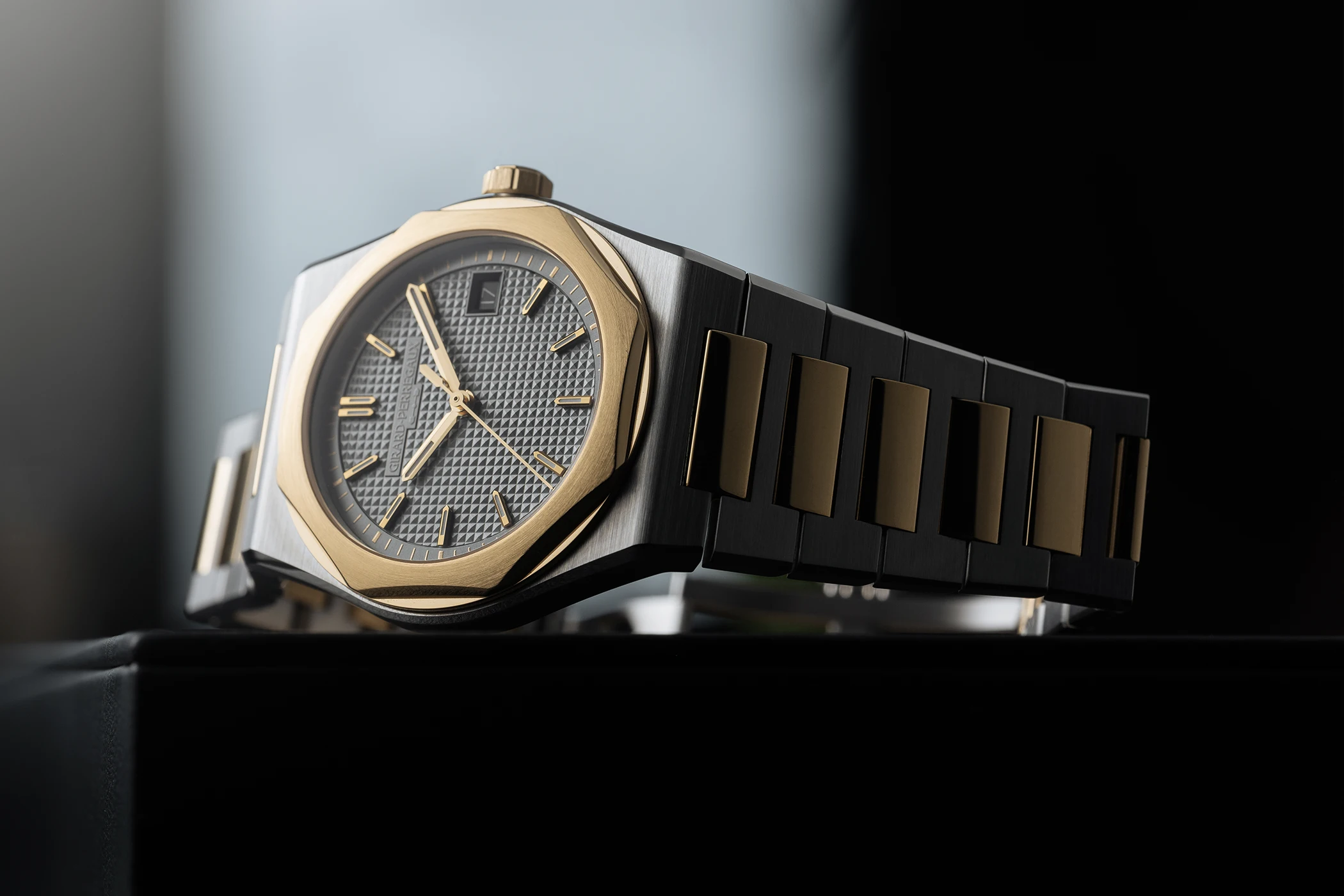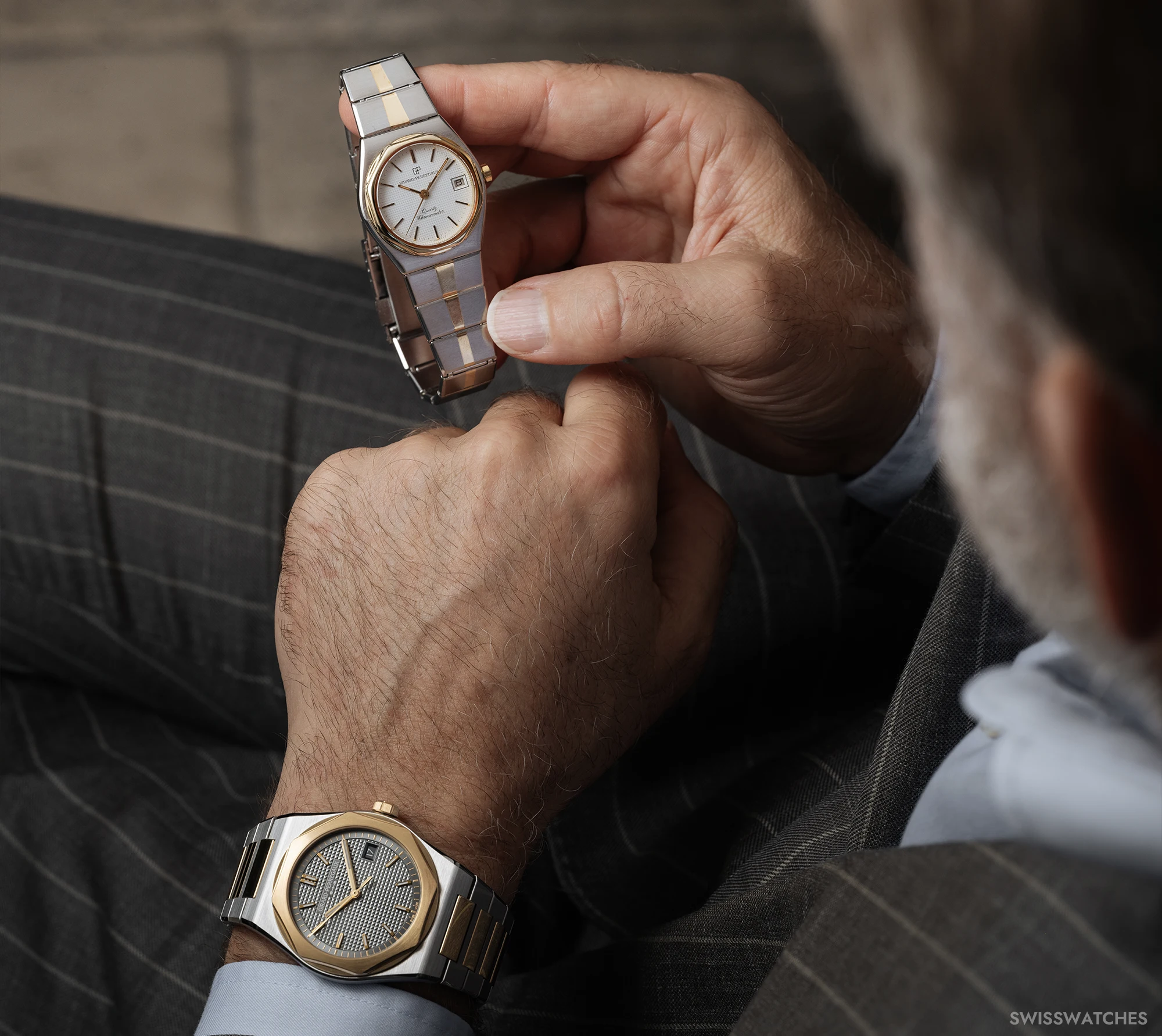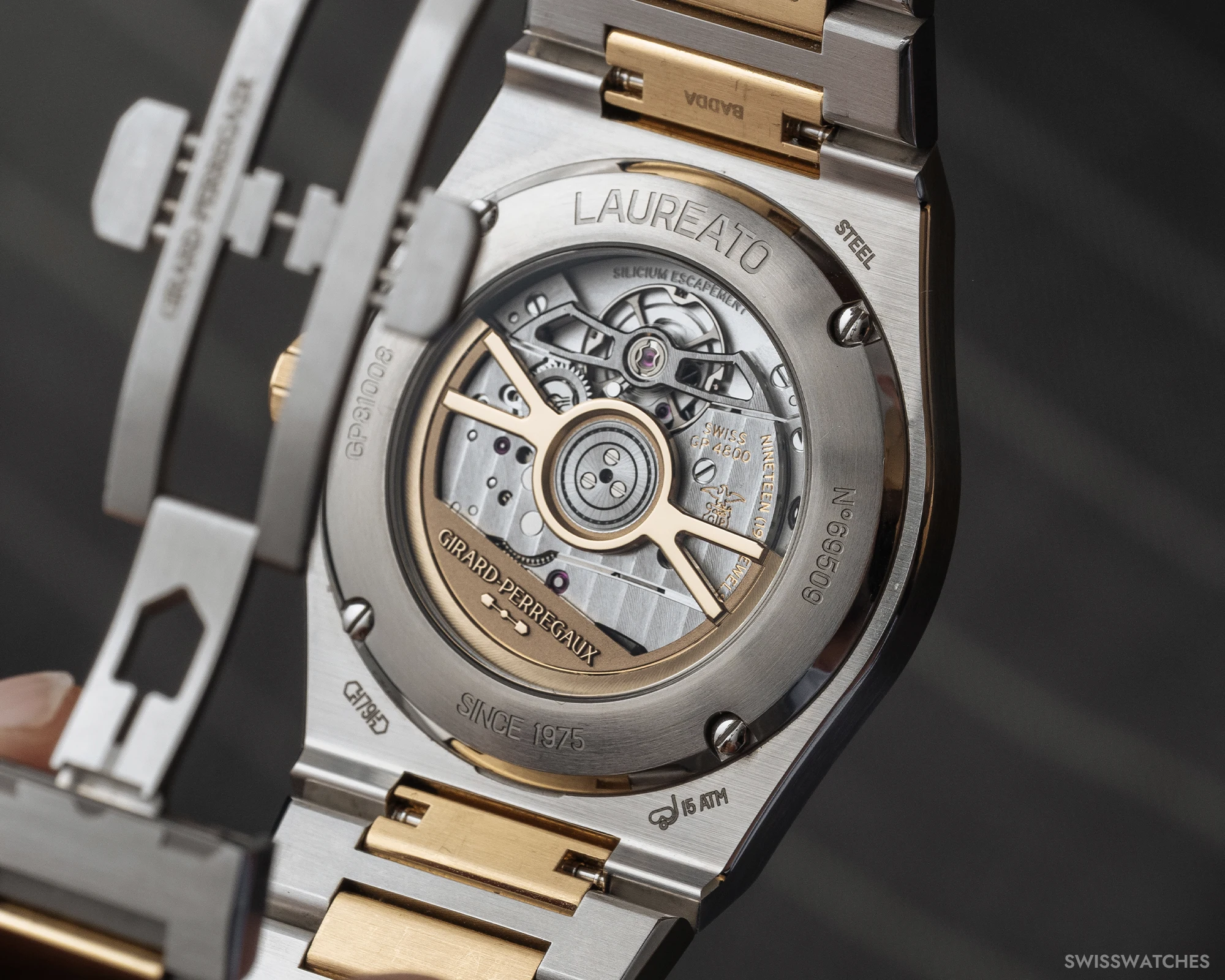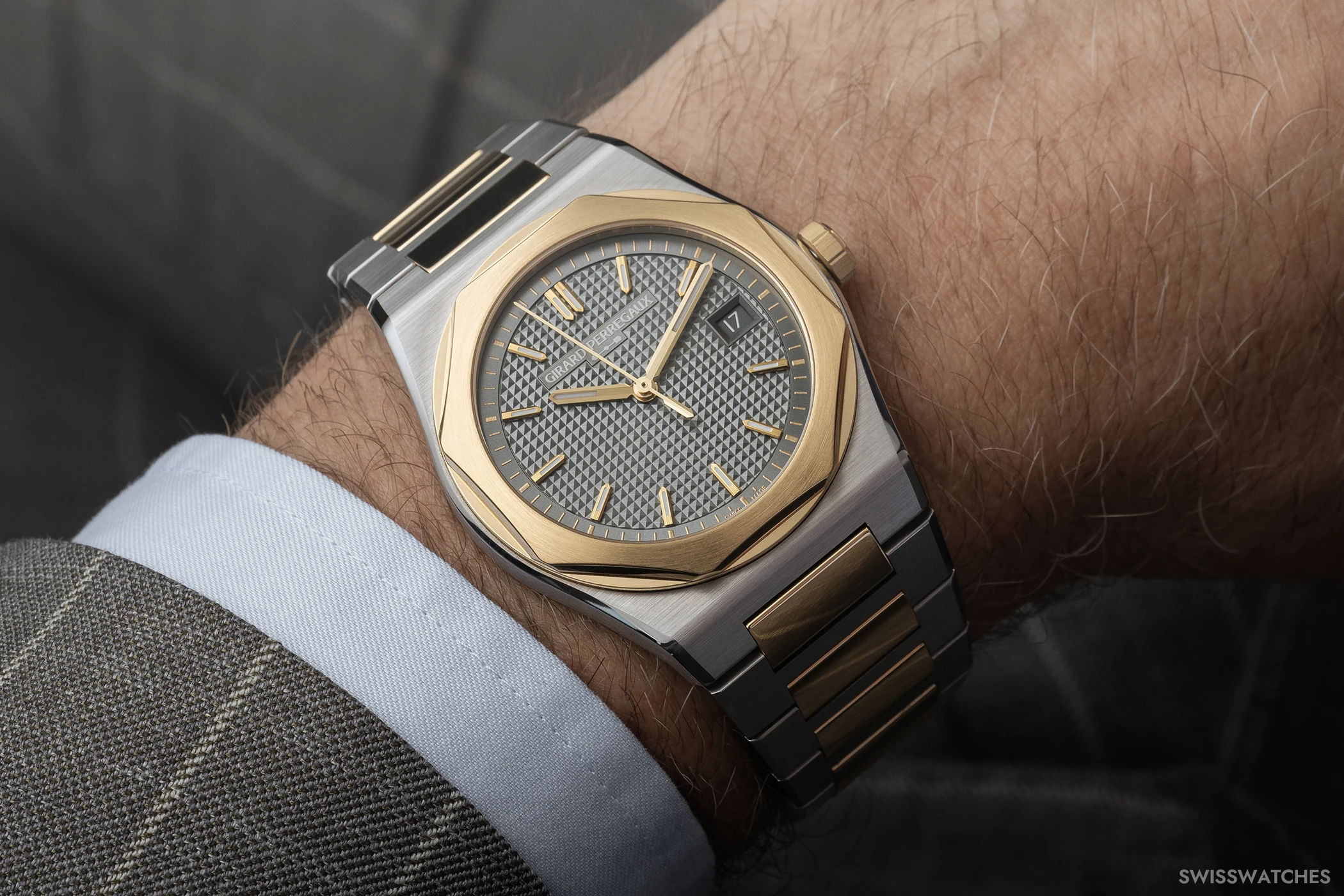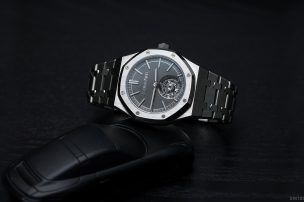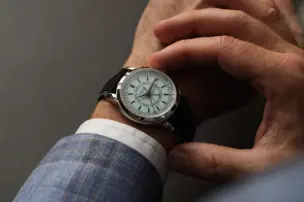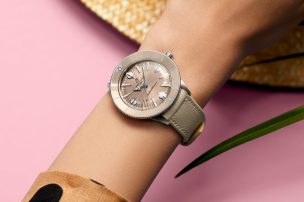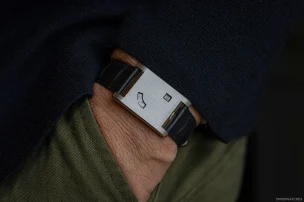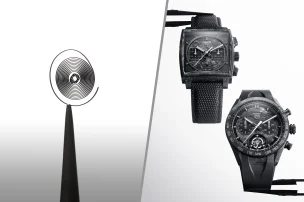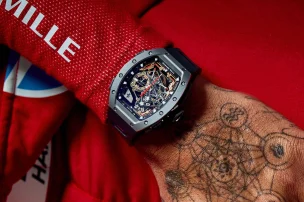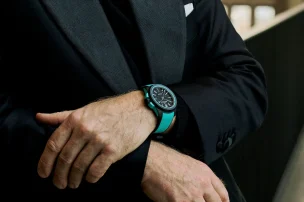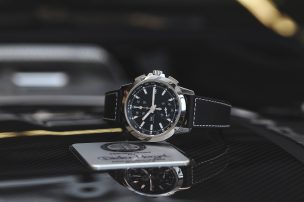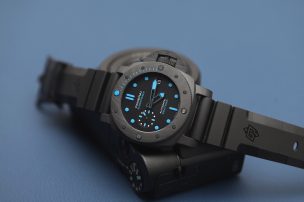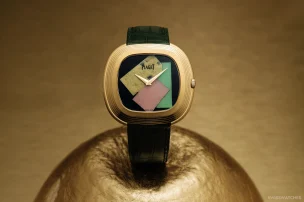
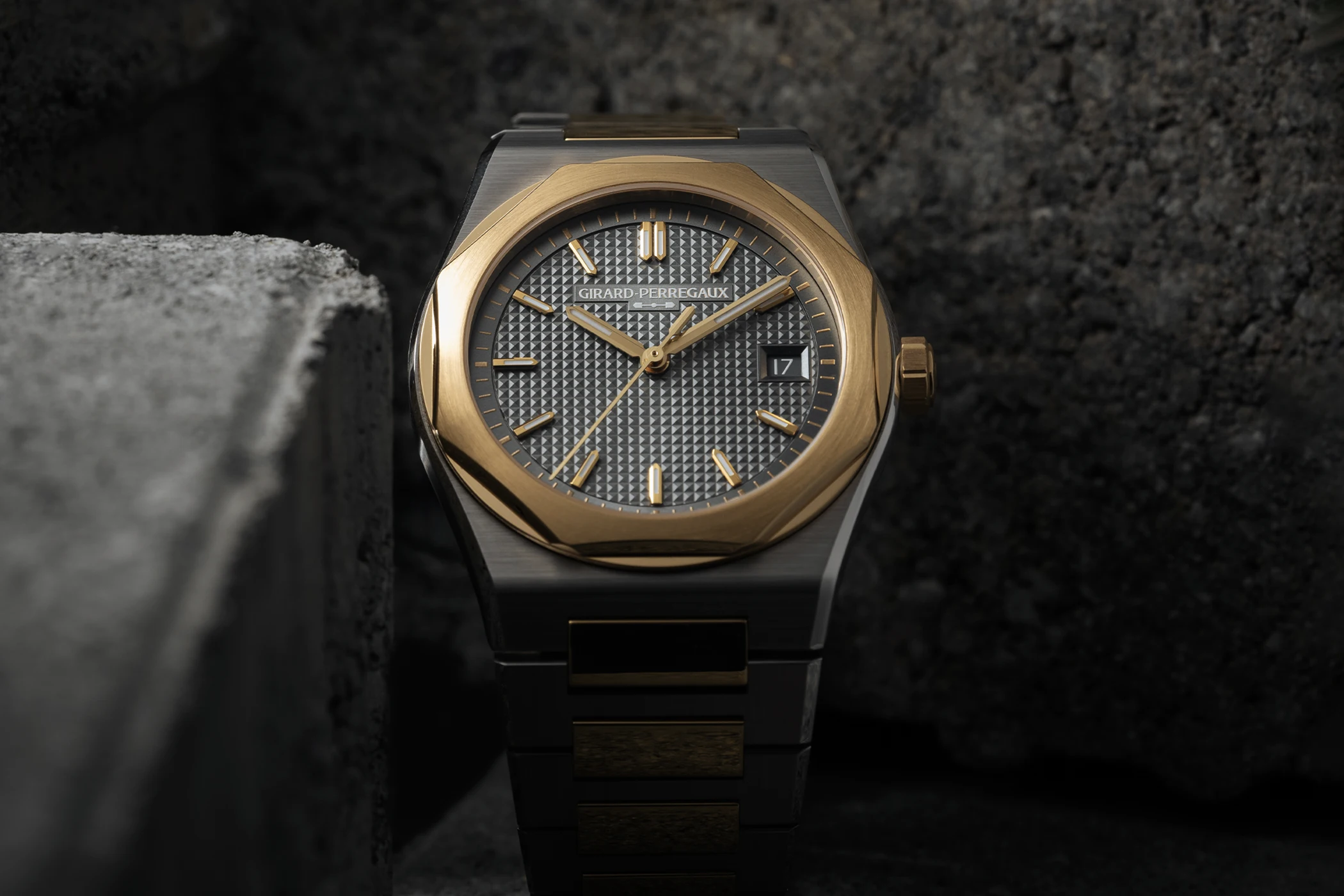
Girard-Perregaux’s Laureato Celebrates Its 50th Anniversary: The Complete History and Highlights of the Legendary Watch
To mark its 50th anniversary, Girard-Perregaux presents the legendary Laureato Fifty model in a limited edition with a completely new movement. Here, collectors will find the whole story and the decisive reason why this watch is a must-have for any collection of steel sports watches with integrated bracelets from the 1970s.
Only a handful of watch manufactures can look back on a history of more than 200 years: Breguet, Blancpain, and Vacheron Constantin still rank among the very best in watchmaking today. Surprisingly, Girard-Perregaux doesn’t spring to mind quite as quickly for most enthusiasts. Yet the manufacture from La Chaux-de-Fonds boasts an impressive 234-year history.
Always committed to precision
Having committed itself to particularly precise timepieces from the outset, it continues to use its own in-house movements to this day and is even one of the five brands that operate on a fully integrated basis. This means that from development and design to movement production, the vertical range of manufacture today far exceeds the 60 per cent required to carry the coveted Swiss Made label. Since the management buyout three years ago under the leadership of Patrick Pruniaux, Chairman and President of the Sowind Group, who is also CEO of Girard-Perregaux, the company has been rightly proud of this achievement.
Design born in-Hhouse
Design is the right keyword. Alongside complex, hand-decorated movements and technically advanced complications such as several calendar equations or even a full globe integrated into the movement, as seen in the Cosmos, Girard-Perregaux also designs all of its watches in-house. This is particularly crucial for the company’s most famous model: the Laureato. This year, the icon is celebrating its 50th anniversary. A special commemorative edition has just been released, which you can find here in the news section. It features a brand-new automatic calibre developed specifically for this watch, the GP4800 – which we have covered in detail previously.
The first comprehensive history of the Laureato by Girard-Perregaux
This article will focus on the detailed history of this series, which could be described as the cornerstone of any collection of steel sports watches from the 1970s with an integrated bracelet. The ‘Glorious Five’ are, of course: Audemars Piguet’s Royal Oak from 1972, the Patek Philippe Nautilus from 1976, IWC’s Ingenieur from the same year, and Vacheron Constantin’s 222 from 1977. Sitting right between them is Girard-Perregaux’s Laureato, launched in 1975. These watches were created to capture a new lifestyle spirit of the 1970s: a more active society that travelled the world by jet and embraced sport. The line between classic dress watches and pure tool watches blurred. These timepieces were expected to do it all – and to be worn everywhere. With their radical new designs compared to the conservative core collections of top maisons, particularly with their integrated steel bracelets, most of them were not instant successes. In fact, many were initially rejected by traditional clients of the great manufactures. Today, however, they are regarded as some of the most sought-after design classics in watchmaking.
Innovative design shaped the 1970s worldwide
Italy in particular produced some extraordinary design objects in the 1960s and 1970s. The country was considered a leader in industrial and automotive design, but also in furniture. Many classics originate from this era of change, a time when it wasn’t just designers who were questioning the status quo.
As there are many legends surrounding the Laureato by GP, but I couldn’t find the true story anywhere, I took it upon myself to discuss the facts with the manufacturer. Many interesting details of the story only became clear to me afterwards.
How did the Laureato come about?
In Italy, Girard-Perregaux’s key distribution partner at the time seized the opportunity to request a special design for its market – the market that was the birthplace of the new design trends described above and was considered to be setting the tone. He asked the GP engineers to create a watch to be considered as a whole, not just as a case with a movement inside. What did he mean by that? Switzerland was facing a double revolution: the quartz crisis changed the very heart of watches, while integrated bracelets redefined their form. Girard-Perregaux embraced both challenges and aimed to create something entirely new. The Laureato was born at the intersection of these two movements – in 1975. In fact, there exists a historic photograph of the distributor examining one of the very first examples.
Who designed the Laureato by Girard-Perregaux?
Before we move on to the movements, let’s return to the design. Girard-Perregaux had this watch developed in-house, even though this is sometimes claimed otherwise. At that time, the company already had its own designers who set to work on developing something special. Experts will know that most watch companies at that time still worked with external designers, as design was often simply not one of their core competencies.
In-house design instead of Gérald Genta
Back then, designers often sold watch models to companies in the form of drawings. That was also the case with the three other important steel icons of the era: all of them came from the hand of the world’s most famous watch designer, Gérald Genta. The Swiss visionary, who is said to have designed around 3,000 watches in his lifetime and founded two watch brands (one of which continues today as the independent brand Gerald Charles, while the other, Genta, belongs to LVMH), created Audemars Piguet’s Royal Oak, Patek Philippe’s Nautilus and IWC’s Ingenieur. Vacheron Constantin’s 222, by contrast, was designed by Jorg Hysek.
Looking at the movements inside these celebrated models makes it even clearer that Girard-Perregaux pursued a very different path to its competitors. The base movements of these icons did not, in fact, come from the manufactures themselves. Audemars Piguet initially used an ETA movement, as did IWC. Patek Philippe and Vacheron Constantin relied on calibres from Jaeger-LeCoultre (then simply ‘LeCoultre’). Only the Laureato was equipped with an in-house movement – albeit a quartz calibre.
Why did Laureato initially use a quartz movement?
At Swisswatches, we don’t normally report on quartz watches, but the historical development of this watch, which ultimately led to exceptional mechanical movements such as the recent new GP4800 calibre, is worth taking a closer look at. The first Laureato was the first quartz chronometer in the entire Swiss watch industry. And unlike its competitors, this model was an instant success. This can be easily verified by the COSC figures: of the 1,000 movements sent to the Controle Officiel Suisse des Chronometres (COSC) testing centre in 1977, exactly 891 models – around 90 per cent – came from Girard-Perregaux.
Why was Girard-Perregaux the only one to launch a quartz watch at the time?
Perhaps we need to zoom out a little to better understand the historical context. Quartz timekeeping devices were first officially used at the 1952 Olympic Games in Helsinki – a turning point in sports chronometry. By the 1964 Olympic Games in Tokyo, the technology had evolved further: quartz-synchronised photo finish cameras were integrated into larger timekeeping systems, enabling unprecedented precision. Swiss manufacturers knew that the technology was unstoppable.
Quartz is the future – but does that apply to every manufacture?
The superior accuracy of quartz technology soon attracted the interest of all Swiss watchmakers, who hoped to miniaturise it for use in wristwatches. As early as 1962, many brands joined forces in Switzerland to form the Centre Electronique Horloger (CEH), with the goal of developing quartz calibres for wristwatches. Not so Girard-Perregaux: the manufacture chose not to join the consortium, convinced of its own technical expertise and determined to develop an independent quartz movement.
One against all: Creating its own research department
Four years later, in 1966, Girard-Perregaux opened a dedicated research and development division for quartz technology. Electronics engineers were recruited for a special project under the direction of Mr Virchaux, then co-managing director of the brand.
After several prototypes, in 1971 the manufacture introduced the GP350 calibre. It was the first movement to oscillate at a frequency of 32,768 hertz and that was suitable for serial production. That may seem unremarkable today, but at the time it was revolutionary. Within only five years, Girard-Perregaux had not only built an in-house quartz research programme from scratch, but also managed to surpass both the Japanese makers and the Swiss consortium – which included none other than Rolex and Patek Philippe – in terms of precision and production feasibility. To put this into perspective: the Swiss consortium’s Beta 21 quartz calibre, unveiled in 1969, oscillated at just 8,192 hertz and was initially not even fit for large-scale production.
A new standard, created by Girard-Perregaux watchmakers
Girard-Perregaux, by contrast, had opted for a high-frequency 32,768-hertz movement. This very frequency remains the benchmark for the entire industry today, and for all quartz watches to come. It is precisely for this reason that the story deserves to be told, even if we as enthusiasts tend to prefer mechanical watches over quartz. It is also worth noting that the official chronometer testing body was not established until 1973. Since then, numerous chronometers have borne the COSC name – a label that became synonymous with certified precision. The founding of this laboratory replaced the various cantonal institutions across Switzerland, such as the Neuchâtel Observatory, consolidating them into a single authority.
1975: The birth of a legend
Two years later, in 1975, the very first Laureato was introduced – equipped with an improved in-house quartz calibre (a smaller, more refined and more elaborately decorated evolution of the GP350) and certified with the prestigious COSC chronometer designation. Incidentally, that is exactly what is written on the white dial. The name was only added in 1995 with the first version featuring an automatic movement.
The watch takes its name from its certificate of accuracy
The COSC certification, whose certificate of accuracy was enclosed with each watch, was also important for another reason: it gave it the Italian name ‘il laureato’, which means ‘the graduate’ in English. As mentioned, the COSC label was new at the time. Now it is easy to understand where the name Laureato comes from. It is an Italian word that means ‘the graduate’ in English. It aptly symbolises the achievement of this watch. It falls more into the category of myths that the model stood out particularly in Italy as an excellent watch for outstanding ‘model students’ and was often gifted to school and university graduates.
What does a film starring Dustin Hoffman have to do with the watch?
Another myth surrounding this watch is completely fabricated: Girard-Perregaux historians clearly refute the claim that the watch was named ‘Laureato’ at the suggestion of Girard-Perregaux’s Italian distributor – a reference to the cult film The Graduate from 1967, which is called ‘il laureato’ in Italian. However, the myth persists to this day, and we would like to emphasise once again that there is no truth to it. After all, the film was released eight years before the watch was launched. The fact that the memorable title of the film, which was a box office hit, corresponds to the nickname of the watch is pure coincidence. Sometimes it pays to take a closer look.
Geneva stripes on quartz movements
Before we close the chapter on quartz, two additional points are worth noting. Firstly, GP continually improved its watches. The battery quickly lasted over two years. However, during the 20 years in which the quartz models were manufactured, it was not only the battery life that changed: the Laureato models introduced in 1984, which had been visually redesigned, were still considered part of the high art of watchmaking: These models, equipped with elaborate calendar functions, even had a glass back through which the hand-finished quartz movements could be seen, which also featured Geneva stripes on the plate. Elaborate pearling and ruby bearings for the gear train were a matter of course for Girard-Perregaux. Even the battery compartment was decorated with perlage, as old pictures show.
How did mechanical movements make their way into this iconic model?
It was only natural that in the mid-1990s the manufacture would launch its first automatic Laureato – precisely at a time when interest in mechanical watches was once again growing strongly. Since then, the Laureato has offered its wearers a choice between in-house developed quartz and automatic calibres. This shift was also thanks to the then-new owner Luigi Macaluso, who took the helm in 1992 and recognised the signs of the times.
1995: The first automatic Laureato is launched
In 1995, the Laureato was launched with a proven slim mechanical movement manufactured by GP: the GP3100 automatic movement was particularly flat and perfectly suited to an elegant sports watch. Just three years later, the GP3300 movement was launched as part of the series. From 2003 onwards, it was installed in the EVO3 series with various modules featuring complications such as a perpetual calendar, a large date display and a moon phase display. In 2017, shortly after the 225th anniversary of the manufacture, the new 3.97 mm-thin GP1800 calibre with 28,800 vibrations per hour and a 54-hour power reserve was introduced for the first time in the Laurerato, a real workhorse that was launched in 2006 and will continue to tick in the models until 2025. Of course, this movement is also elaborately decorated by hand: the nine finishes include the following refinements: Côtes de Genève and perlage finishing, bevelled edges, (laser) engravings with a gold tone, mirror polishing, satin finishing, circular and sunburst finishing.
I still remember the 225th anniversary in 2016 well, because that was when the Laureato case was completely redesigned. Let’s take a closer look at the case design since its inception.
What are the design hallmarks of the classic Laureato?
The Laureato’s design is defined by its raised octagonal bezel set on a circular base, a clous de Paris guilloché dial, and baton hands and indices (although some versions with Roman numerals were also made). Particularly striking are the contrasting surface finishes, alternating between polished and satin-brushed areas, and of course the fully integrated bracelet without traditional lugs.
In the first version, the Laureato was truly tiny.
In its earliest versions, the Laureato was quite small, available in 26 mm, 30 mm and 35 mm models. The very first version of the Laureato had a diameter of only 30 millimetres. The dial featured only the company logo and the addition of ‘Quartz Chronometer’ at 6 o’clock. The bracelet links spanned the entire width of the watch but were two-tone. Nine years later, the 35 mm model was released, still without the Laureato name on the dial. With the references 42664, 42665, and 42668, models with various elaborate calendar complications were introduced for the first time, an effective means of demonstrating the performance of quartz technology in combination with genuine watchmaking craftsmanship.
The second generation from 1984 already shows the introduction of intermediate links in the bracelet with a narrower link width. They were most likely intended to make it easier to adjust the size for both men and women.
The watches grow in size
About ten years later, interest in mechanical movements surged once more, and the Laureato 8010 was launched with the aforementioned GP3100 calibre. Its diameter grew to 36 mm, and that same year saw the introduction of the first automatic chronograph: the Olympico. The 40 mm version carried the reference 80170.
By this time, quartz technology had become widespread and no longer seemed particularly exclusive to clients, although a quartz option remained available for the ladies’ model. The bracelet links were reshaped into a tapered form, echoing the clous de Paris pattern on the dial. In 1996, Girard-Perregaux also released a 36 mm bicolour model, reference 80100, closely inspired by the original 1975 design, complete with a white dial.
The legend is refined every ten years
A pattern emerges: Girard-Perregaux has consistently updated the Laureato roughly every decade. This year is no exception, with a completely redesigned watch and a new calibre tailored specifically for this model. The goal is to bring the contemporary Laureato as close as possible to the ultra-thin quartz watches of the past while satisfying the desire of many clients for elegantly slender timepieces.
Let’s now highlight some of the standout models and complications in the Laureato’s evolution.
Which Laureato models should you be familiar with, and what complications are available?
In 2018, the first skeletonised model, the Laureato Skeleton, was launched – later attracting attention in a striking black ceramic version. The first tourbillon appeared in a Laureato in 1997. This third-generation model was also the first to integrate Girard-Perregaux’s legendary three bridges into the iconic Laureato design. The reference 99070, with a 40 mm case, was comparatively compact.
The fourth generation: Laureato Evo3
The fourth generation responded to clients’ growing demand for larger case diameters. In 2003, the first model of this generation appeared: the Evo3 Chronograph, housed in a 44 mm case (reference 801800.11.6516). Another variation of the three bridges was introduced twice in the fourth generation – once with sapphire bridges and once with spinel bridges. These tourbillon models caused a stir, as a tourbillon complication had previously not been used in sports watches. With these Laureato models, the manufacture demonstrated its expertise, offering customers tourbillon-equipped sports watches that passed the rigorous Chronofiable tests. To earn Chronofiable certification, a watch must undergo tests simulating years of wear: accelerated wear cycles equivalent to six months to three years of use, shock tests, functional tests at temperatures from –10 °C to +60 °C and up to 85 per cent humidity, vibration and magnetic field tests, as well as long-term operation tests spanning several weeks to detect potential weaknesses.
2016: Relaunch for the 225th anniversary of the Maison
The Evo3 generation may now seem a little oversized, but it reflected the sporty aesthetic of its time: bigger was better. A minor side note: in 2010, Girard-Perregaux celebrated the 40th anniversary of its first quartz wristwatch calibre with a special Evo3 quartz model – the only Laureato quartz piece of that era. The stylistic shift arrived in 2016, when the manufacture marked its 225th anniversary with the latest Laureato, featuring an updated silhouette.
A limited special edition for the launch
The Laureato Heritage, with a 41 mm steel case and blue dial, was limited to 225 pieces. All watches were water-resistant to 100 metres. In 2017, a new base model appeared with a 42 mm case, alongside a smaller 38 mm version. In 2018, the line expanded with a new chronograph, a tourbillon, and a beautiful 42 mm titanium model in a bicolour titanium case, paying homage to the original.
Fifth generation: Laureato Absolute
Since 2019, the fifth generation – the Laureato Absolute – has been available. It can be understood as the sporty counterpart to the classic Laureato, much like the Royal Oak Offshore relates to Audemars Piguet’s Royal Oak. These highly athletic watches, with 44 mm cases, appeared in titanium with black PVD coating, rubber straps and blue dials, available as chronographs, three-hand models, and world-time versions. Today, the series also includes chronographs in carbon-fibre cases. For the first time, the perpetual calendar became available in a 42 mm steel case within the classic Laureato line. A standout piece is the Laureato Absolute Light, crafted in a transparent sapphire case
Is the new Laureato a success for its 50th anniversary?
Girard-Perregaux describes the new, unfortunately limited-to-200-piece edition, the Laureato Fifty, as ‘directly inspired by the original.’ Let’s take a closer look. For the first time, the Laureato is now offered in a 39 mm case, which – it must be said – sits perfectly on the wrist. This is largely thanks to the reduced thickness of 9.8 mm, roughly one millimetre less than previous models (depending on whether you compare the 38 mm and 42 mm Laureato). In this industry, however, a millimetre can make all the difference.
The original spirit
The combination of steel and yellow gold in the case perfectly captures the spirit of the original. Of course, a 30 mm quartz wristwatch from 1975 is an entirely different story, so any comparison will inevitably fall short. Perhaps the best way to put it is this: in my mind, I’ve always imagined the original looking like this newly presented model. You can feel that nothing on this watch has been left to chance.
Everything has been improved
The bracelet is particularly striking, now with an even better integration to the case. The clasp features an innovative micro-adjustment system, allowing the bracelet length to be fine-tuned by up to 4 mm, an especially useful feature in warm weather. The sunray grey clous de Paris dial has a pleasing three-dimensional effect and complements the watch far better than the original white dial from 1975. The GP4800 calibre movement, the heart of the edition, appears to have been designed specifically for this watch. Successfully integrating the symmetrical three-bridge architecture into the movement is a testament to the house’s savoir-faire.
Improved water resistance
Water resistance has also been upgraded, now rated to 150 metres. Colleagues have already covered the watch and movement in detail in previous articles; the final verdict: outstanding, once again. The Laureato Fifty arrives at the perfect moment. For collectors, it’s not just about rediscovering a new legend, but also appreciating a manufacture that has remained at the pinnacle of watchmaking for 234 years. Other brands may be bolder today, but for anyone seeking a mechanical watch that has consistently led the way in technological excellence, this is the place to look. The Laureato Fifty is arguably the most understated way to wear one of the “Glorious Five” icons of the 1970s sports-chic era. One can only look forward to which serial models will follow next year. What’s still missing is a fully integrated chronograph movement – but rumours suggest it is already in development. In the meantime, we can patiently await the new complications of the GP4800. After all, every legend ticks a little differently.
